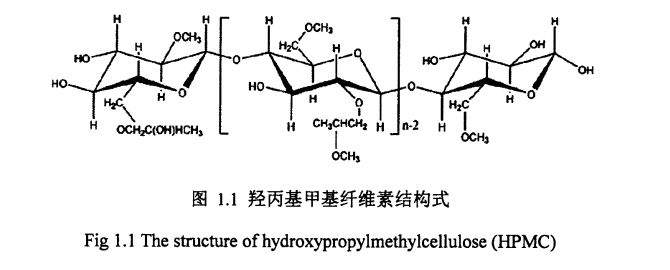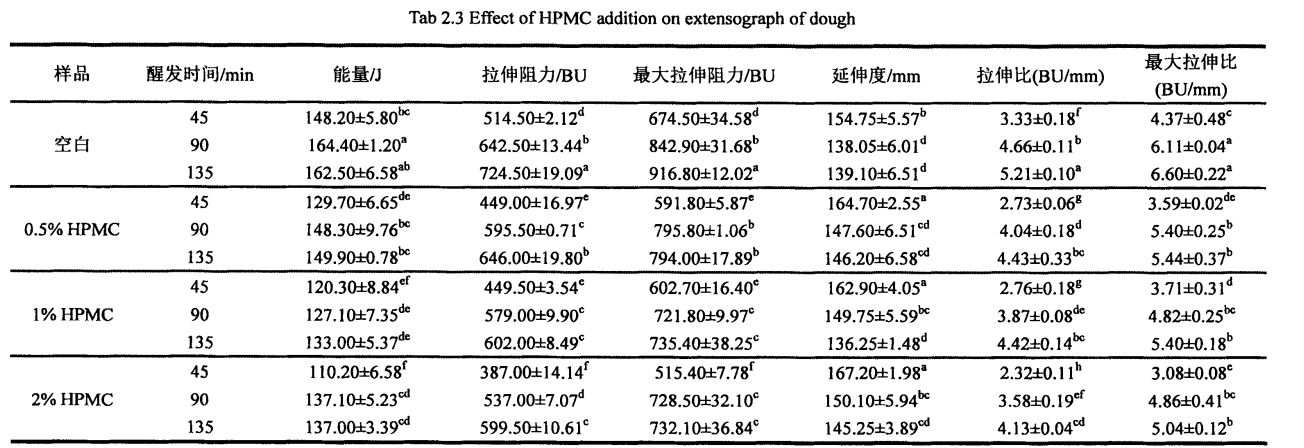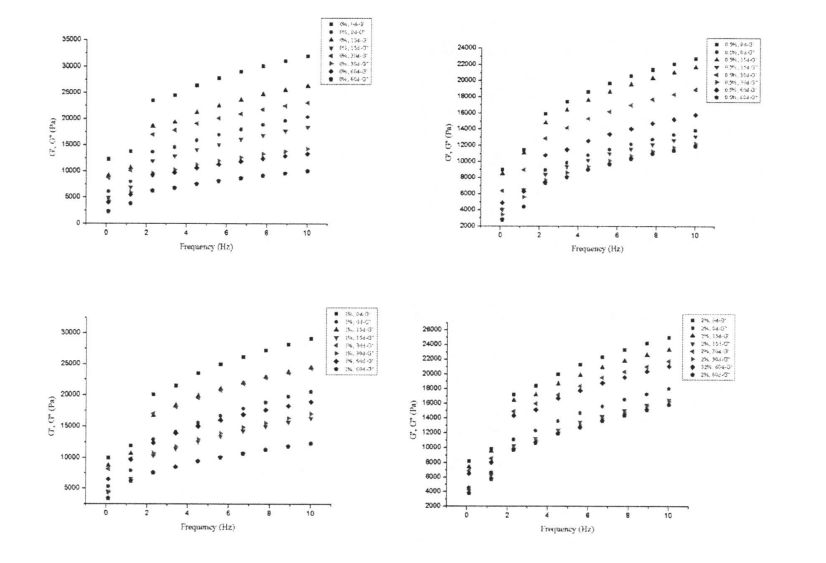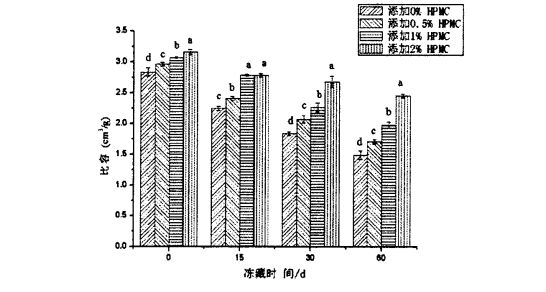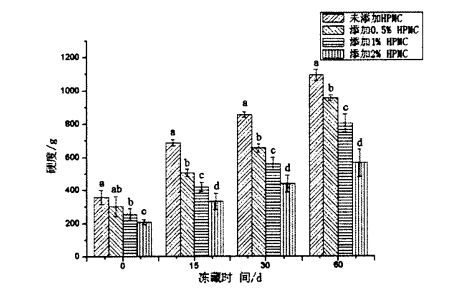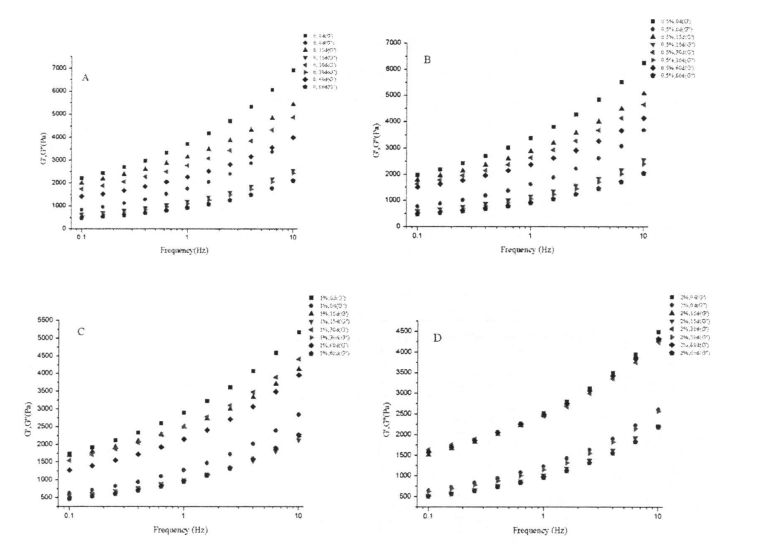Déi experimentellen Resultater vun der Grenzfäegkeet a Stretching, déi gewisen datt d'Zouschung vun HPMC d'Veraarbechtung vun den Daach agedréit, datt d'viosnastRakial vun den Tippelungs-Reconditur entstan ginn. Zousätzlech gouf et mam Kontrollgrupp verglach mam CPMC, ass de spezifesche Velumomie an Ellastik vun denen gedenken.
Wheat gluten is the material basis for the formation of dough network structure. Experiments found that the addition of I--IPMC reduced the breakage of Yd and disulfide bonds between wheat gluten proteins during frozen storage. Ausserdeem ass d'Resultater vun niddereg-fläissen nulsemaresche Wuesstruktioun an den Ëmfeld vum Ratialssconatioun a Racken vun der Auslänner. Scanning electron microscope showed intuitively that the addition of HPMC could maintain the stability of gluten network structure.
Key words: steamed bread; frozen dough; hydroxypropyl methylcellulose; Weess Gluten; what Stärch; yeast.
1.1.6 Applikatioun vu Hydrocoloiden a gefruerene Teig Qualitéitsverbesserung ......................5
1.1.7 Hydroxypropyl methyl cellulose (Hydroxypropyl methyl cellulose, I-IPMC) ………. 5-
2.3 Experimental results and discussion…………………………………………………………………… . 11 Mee
2.3.3 Den Effekt vun HPMC Zousaz op der Tensile Eegeschafte vum Teig .............................. 12
2.3.4 Den Effekt vun HPMC Zousteren a Gefrinzungen op der rhologescher Eeneg Eegenschafte ............ ............................................................................................................................15
23.5 Effekter vum HPMC Zousazbetrag a Gefrierungspäicherzäit op der geféierlech Waasserinhalt (GW) an gefruerene Täsch ....................................................
2.3.6 Den Effekt vun HPMC Zousatz a Gefriesszäit op der Qualitéit vun der Streck vum gedämpften Brout ...........................................................................
3.2.4 experimentell Methoden ................................................................................................... 25 E 25
3.3.2 The effect of adding amount of HPMC and freezing storage time on the freezable moisture content (CFW) and thermal stability……………………………………………………………………. 30
3.3.3 Effekter vum HPMC Zousazbetrag a Gefrinzénger Späicherzäit op gratis sifhydryl Inhalt (C Schëff) ............................................................................................................................................................................................................................................ . 34 Ëmpf no 34
3.4 Kapitel summy ...........................................................................................................................
4.1 Introduction .............................................................................................................................. . 44
4.2 Experimental materials and methods ................................................................................. 45 Ë5
4.3 Analysis and discussion ........................................................................................................... 48
4.3.1 Content of basic components of wheat starch ……………………………………………………. 48
4.3.3 Effects of HPMC addition and freezing storage time on the shear viscosity of starch paste………………………………………………………………………………………………………………………………………. 52 Ënnert mechsten
4.3.6 Effects of I-IPMC addition amount and frozen storage time on the thermodynamic properties of starch ………………………………………………………………………………………………………. . 57 Ëmeier
4.3.7 Effekter vum HPMC Zousazbetrag a Gefrierungspäicherzäit op der relativer Kristallinitéit vum Starch ........................................
Chapter 5 Effects of HPMC addition on yeast survival rate and fermentation activity under frozen storage conditions………………………………………………………………………………………………. . Nee 62
5.1Introduction .................................................................................................................................... Nee 62
5,2 Materialien a Methoden ....................................................................................................................... Nee 62
5.2.2 experimentell Methoden. An. An. . An. ......................................................................................... 63.
5.3 Results and Discussion ............................................................................................................... 64 Oawom
5.3.3 The effect of adding amount of HPMC and freezing time on the content of glutathione in dough……………………………………………………………………………………………………………66. "
5.4 Chapter Summary ........................................................................................................................ 67 Ënner 67
Kapitel 6 Conclusiounen a Perspektiven .................................................................................................. 68
6.1 Conclusion ................................................................................................................................. . 68
6.2 Outlook .......................................................................................................................................... 68
Lëscht vun Illustratiounen
Figur 1.1 Déi strukturell Formel vun der Hydroxypyl methycellose ........................ . 6
Figure 2.4 The effect of HPMC addition and freezing time on the elasticity of steamed bread………………………………………………………………………………………………………………………………. . 20
Bild 3.1 Den Effekt vun HPMC Zousatz a Gefriesszäit op de rhenologeschen Eegeschafte Gluten .................................................... 30
Figure 3.2 Effects of HPMC addition and freezing time on the thermodynamic properties of wheat gluten………………………………………………………………………………………………………………. . 34 Ëmpf no 34
Figure 3.3 Effects of HPMC addition and freezing time on free sulfhydryl content of wheat gluten……………………………………………………………………………………………………………………………... . 35
Bild 3.6 Illustratioun .................................................................................................................... ....39
Figure 3.7 The effect of HPMC addition and freezing time on the microscopic gluten network structure…………………………………………………………………………………………………………... . 43
Figure 4.1 Starch gelatinization characteristic curve ............................................................... 51 51
Figure 4.2 Fluid thixotropy of starch paste ................................................................................. 52 Ënnert mechsten
Figur 4.3 Effekter vum Mc a Freezing Zäit op der Viskcoelastie vu Starch Paste ................................................ 57 Ëmeier
Bild 4.4 Den Effekt vun HPMC Zousatz a Gefriess Späicherzäit op Starch Schwellungsfäegkeet ............................................
Figur 4,5 Effekter vun HPMC Zousaz a Gefriess Späicherzäit op den thermodynamesche Eegeschafte vu Starch ........................................................................ . 59
Figur 5.1 Den Effekt vun HPMC Zousatz a Gefriesszäit op der Beweiser Héicht vum Teig ...............................................
Figure 5.2 The effect of HPMC addition and freezing time on the yeast survival rate…………………………………………………………………………………………………………………………………... . 67 Ënner 67
Figure 5.3 Microscopic observation of yeast (microscopic examination) …………………………………………………………………………………………………………………………. 68
Table 2.1 The basic ingredient content of wheat flour…………………………………………………. 11 Mee
Dësch 3.1 Inhalt vun Basis Zutaten am Gluten ................................................................................25
Table 3.2 Effects of I-IPMC addition amount and freezing storage time on the phase transition enthalpy (Yi IV) and freezer water content (e chat) of wet gluten………………………. 31
Table 3.3 Effects of HPMC addition amount and freezing storage time on the peak temperature (product) of thermal denaturation of wheat gluten…………………………………………. 33
Tabell 3.4 Peak Position vu Protein Secondaire Strukturen an hir Uerderen ............37
Table 3.6 Effects of I-IPMC addition and freezing storage time on the surface hydrophobicity of wheat gluten……………………………………………………………………………………………. 41 HUNN !!!
Table 4.3 Effects of I-IPMC addition and freezing time on the shear viscosity of wheat starch paste…………………………………………………………………………………………………………………………. 555
1.1.1Introduktioun op gedämpft Brout
Steamed bread refers to the food made from the dough after proofing and steaming. As a traditional Chinese pasta food, steamed bread has a long history and is known as "Oriental Bread". Because its finished product is hemispherical or elongated in shape, soft in taste, delicious in taste and rich in nutrients [l], it has been widely popular among the public for a long time. It is the staple food of our country, especially the northern residents. Ugezellen Concept fir ongeféier 2/3 vun der Diätung vun de Proffen an ongeféier 46% vum Nordaarstquluminformitéit an der Landsmänn an der Stad.
1)Development of new characteristic steamed buns. Bis d'Innovatioun vun gedämpfter Flüchtflächepateraterateraterialien an Zich vu funktionnler aktiv Substanzen kënnen, nei Variantesch Brout a Funktioun. Established the evaluation standard for the quality of miscellaneous grain steamed bread by principal component analysis; Fu et a1. (2015) added lemon pomace containing dietary fiber and polyphenols to steamed bread, and evaluated the antioxidant activity of steamed bread; Hao & Beta (2012) studied barley bran and flaxseed (rich in bioactive substances) The production process of steamed bread [5]; Shiau et a1. (2015) evaluated the effect of adding pineapple pulp fiber on dough rheological properties and steamed bread quality [6].
2)Research on the processing and compounding of special flour for steamed bread. The effect of flour properties on the quality of dough and steamed buns and the research on new special flour for steamed buns, and based on this, an evaluation model of flour processing suitability was established [7]; for example, the effects of different flour milling methods on the quality of flour and steamed buns[7] 81; Den Effekt vun der Verbindung vu verschiddene Waxsoft Weessfaarf op der Qualitéit vum gedämpften Brout [9J et al.; Zhu, Huang, &Khan (2001) evaluated the effect of wheat protein on the quality of dough and northern steamed bread, and considered that gliadin/ Glutenin was significantly negatively correlated with dough properties and steamed bread quality [lo]; Zhang, et A1. (2007) analyzed the correlation between gluten protein content, protein type, dough properties and steamed bread quality, and concluded that the content of high molecular weight glutenin subunit (1ligh.molecular-weight, HMW) and total protein content are all related to the quality of northern steamed bread. e wichtegen Impakt [11] hunn.
4) Fuerschung op der Qualitéitsverbesserung vun gedämpfter Brout. Fuerschung op der Zousatz an d'Applikatioun vu gedämpfter Broutqualitéit verbessert; mainly including additives (such as enzymes, emulsifiers, antioxidants, etc.) and other exogenous proteins [14], starch and modified starch [15], etc. The addition and optimization of the corresponding process It is particularly noteworthy that in recent years, through the use of some exogenous proteins and other additives, gluten-free (free. gluten) pasta products have been developed to meet the requirements of celiac Krankheet (Diätbehëllef vu Patienten mat Celliac Krankheet [16.1 Zit.
Geméiss dem Produktiounsprozess, gefruer Teig kann ongeféier a véier Zorten opgedeelt ginn.
D) Ganz veruertebedte gefruerten Taug: den Teig ass an ee Stéck gemaach a geformt, da voll forméiert an d komplette gekillt, och gefruerend a gesammelt, Gefäller, Gefäller a goufen gefruer an gedréchnen a gelagert gëtt, gefruer an ausgeschafft ginn.
Most studies have found that the formation and growth of ice crystals in frozen foods is an important factor leading to the deterioration of product quality [291]. Ice crystals not only reduce the survival rate of yeast, but also weaken the gluten strength, affect the starch crystallinity and gel structure, and damage the yeast cells and release the reducing glutathione, which further reduces the gas holding capacity of gluten. Ausserdeem huet am Fall vun der Froutzer Späicher, Temperatur Schwankzentnungs-Spiller well Äisbäi Kaler a géif wéinst der Reduktiounsgerand wuessen [30]. Therefore, how to control the adverse effects of ice crystal formation and growth on starch, gluten and yeast is the key to solving the above problems, and it is also a hot research field and direction. An de leschten zéng Joer sinn vill Fuerscher an dësem Aarbechte beschäftegt an huet e puer fruchtbar Fuerschung Resultater erreecht. Wéi och ëmmer, et gi kee bësse Lücken an der Unterreloritéitspolitesch Themen zu dësem Beräich, wat och ëmmer weider exklusiv Explorespär muss ginn, och.
a)How to restrain the quality deterioration of frozen dough with the extension of frozen storage time, especially how to control the influence of the formation and growth of ice crystals on the structure and properties of the three main components of dough (starch, gluten and yeast), is still an issue. Hotspots an fundamental Themen an dësem Fachfeld Feld;
II. Optimization of frozen dough production process, frozen storage conditions and formula. During the production of frozen dough, temperature control, proofing conditions, pre-freezing treatment, freezing rate, freezing conditions, moisture content, gluten protein content, and thawing methods will all affect the processing properties of frozen dough [37]. In general, higher freezing rates produce ice crystals that are smaller in size and more uniformly distributed, while lower freezing rates produce larger ice crystals that are not uniformly distributed. In addition, a lower freezing temperature even below the glass transition temperature (CTA) can effectively maintain its quality, but the cost is higher, and the actual production and cold chain transportation temperatures are usually small. In addition, the fluctuation of the freezing temperature will cause recrystallization, which will affect the quality of the dough.
III. Using additives to improve the product quality of frozen dough. In order to improve the product quality of frozen dough, many researchers have made explorations from different perspectives, for example, improving the low temperature tolerance of material components in frozen dough, using additives to maintain the stability of the dough network structure [45.56], etc. Among them, the use of additives is an effective and widely used method. Mainly include, i) enzyme preparations, such as, transglutaminase, O [. Amylias; ii) emulsifiers, such as monoglyceride stearate, DATEM, SSL, CSL, DATEM, etc.; iii) antioxidants, ascorbic acid, etc.; iv) polysaccharide hydrocolloids, such as guar gum, yellow Originalgum, gum Arabic, konjac gum, sodium alginate, etc.; v) other functional substances, such as Xu, et a1. (2009) added Ice-structuring Proteins to wet gluten mass under freezing conditions, and studied its protective effect and mechanism on the structure and function of gluten protein [y71.
The chemical nature of hydrocolloid is a polysaccharide, which is composed of monosaccharides (glucose, rhamnose, arabinose, mannose, etc.) through 0 [. 1-4. Glykosidesch Obligatioun oder / an a. 1--"6. Glycosidic bond or B. 1-4. Glycosidic bond and 0 [.1-3. The high molecular organic compound formed by the condensation of glycosidic bond has a rich variety and can be roughly divided into: ① Cellulose derivatives , such as methyl cellulose (MC), carboxymethyl cellulose (CMC); ② plant polysaccharides, such as konjac gum, guar gum, gum Arabic ; ③ seaweed polysaccharides, such as seaweed gum, carrageenan; ④ microbial polysaccharides, such as Xanthan gum .Polysaccharide has strong hydrophilicity because it contains a large number of hydroxyl groups that are easy to form hydrogen bonds with water, and has the functions of controlling the migration, state and distribution of water in the food system. Therefore, the addition of hydrophilic colloids gives food Many functions, properties, and qualities of hydrocolloids are closely related to the interaction between polysaccharides and water and other macromolecular substances. At the same time, due to the multiple functions of thickening, stabilizing, and water retention, hydrocolloids are widely used to include in the food processing of flour products. Wang Xin et al. (2007) studied the effect of adding seaweed polysaccharides and gelatin on the glass transition temperature of dough [631. Wang Yusheng et al. (2013) believed that compound addition of a variety of hydrophilic colloids can significantly change the flow of dough. Change the properties, improve the tensile strength of the dough, enhance the elasticity of the dough, but reduce the extensibility of the dough [delete.
Hydrouxpropyl methyl Cellulose (Hydrouxpyl Methyl Cellulose, HPMC) ass eng natierlech op de Kellellylyl op der Kellellyl The United States Pharmacopeia (United States Pharmacopeia) divides HPMC into three categories according to the difference in the degree of chemical substitution on the side chain of HPMC and the degree of molecular polymerization: E (Hypromellose 2910), F (Hypromellose 2906) and K (Hypromellose 2208).
Due to the existence of hydrogen bonds in the linear molecular chain and crystalline structure, cellulose has poor water solubility, which also limits its application range. However, the presence of substituents on the side chain of HPMC breaks the intramolecular hydrogen bonds, making it more hydrophilic [66l], which can quickly swell in water and form a stable thick colloidal dispersion at low temperatures Tie. As a cellulose derivative-based hydrophilic colloid, HPMC has been widely used in the fields of materials, papermaking, textiles, cosmetics, pharmaceuticals and food [6 71]. In particular, due to its unique reversible thermo-gelling properties, HPMC is often used as a capsule component for controlled release drugs; in food, HPMC is also used as a surfactant, Thickeners, emulsifiers, stabilizers, etc., and play a role in improving the quality of related products and realizing specific functions. Zum Beispill, den Déngscht vun HPMC kann d'Geatdinisar Relance Charakteriste vu Stärchungsable änneren a reduzéieren d'De Geld-Stäerech vum Stärappfeller ze reduzéieren. , HPM kann de Verloscht vu Fisteles fir Brout reduzéieren, reduzéieren d'Hardwarenz vu Brout Kär, An effiffentlech Kär hunn.
Effekter vun Zousätzlech Betrag a gefruerene Späicherzäit op der Struktur an Eegeschafte vu gefruerene Teig, d'Qualitéit vu gefruerene Teigprodukter (gedämpft Brout), d'Struktur an Eegeschafte vu Weess) d'Struktur vu Weessbau an d'Struktur Based on the above considerations, the following experimental design was made in this research topic:
1) Wielt eng nei Zort hydrophesch coloid, hydroyopyl methmelleschen (HPMC) a Studings de Site heescht 30, fir 60 Deeg Et existéieren (0, 30, fir 60 Deeg Dat man, a gëtt den Tournoi vun engem Ëmlafbunns (0, 60 Deeg; (0%, 0.5%, 1%, 2%; the same below) on the rheological properties and microstructure of frozen dough, as well as on the quality of the dough product - steamed bread (including the specific volume of steamed bread) , texture), investigate the effect of adding HPMC to the frozen dough on the processing properties of the dough and the quality of steamed bread, and evaluate the improvement effect of HPMC on the processing properties of the frozen dough;
4) vun der Persuerdal fir de Verbesserungsmillmechikoren an der Fern Kont vun verschiddene HPMC als eng Behënnerung vun de fräier Reiever ënner anerem Gefler op Heefft ënner anerem Gefor ënner anerem Gefut ze frompelen.
Instrument an Ausrüstung Numm
BPS. 500CL constant temperature and humidity box
Pudder Meter. E
Extensometer. E
Discovery r3 Rotatiounsrahometer
Hiersteller
Peking bo Yi Kang experimentell Instrument Co., Ltd.
Schottou maachen d'Irschafte Komforter eraus no der entspriechend Quellzäiten am 4 Grad Centno fir wéi wann d'Raumfer a Richtung Raum a Secher-Portitien ofmisst ginn. The sample processing method is also applicable to the experimental part of 2.3.6.
A sample (about 2 g) of the central part of the partially melted dough was cut and placed on the bottom plate of the rheometer (Discovery R3). First, the sample was subjected to dynamic strain scanning. The specific experimental parameters were set as follows: A parallel plate with a diameter of 40 mm was used, the gap was set to 1000 mln, the temperature was 25 °C, and the scanning range was 0.01%. 100%, the sample rest time is 10 min, and the frequency is set to 1Hz. Der linearer Vispelcoelastyity Regioun (Lvr) vun de getestene Proben goufen duerch Stamm Scannen bestëmmt. Then, the sample was subjected to a dynamic frequency sweep, and the specific parameters were set as follows: the strain value was 0.5% (in the LVR range), the resting time, the fixture used, the spacing, and the temperature were all consistent with the strain sweep parameter settings. Fënnef Date Punkten (Parzellen) goufen an der Rhenologiekurve fir all 10-falf Erhéijung vun der Frequenz (linear Modus) opgeholl). After each clamp depression, the excess sample was gently scraped with a blade, and a layer of paraffin oil was applied to the edge of the sample to prevent water loss during the experiment. Each sample was repeated three times.
Weigh a sample of about 15 mg of the central part of the fully melted dough, seal it in an aluminum crucible (suitable for liquid samples), and measure it with a Differential Scanning Calorimetry (DSC). The specific program parameters are set. As follows: first equilibrate at 20°C for 5 min, then drop to .30°C at a rate of 10"C/min, keep for 10 min, and finally rise to 25°C at a rate of 5"C/min, the purge gas is nitrogen (N2) And its flow rate was 50 mL/min. Wéi eng eidel Alumumumum propper an enger Refloss, déi Dréideeg erreecht gouf, an d'Schéissegelumen op ongeféier enger Léisung). Zee Schutz op ongeféier 0 ° CA. Freezable water content (CFW) is calculated by the following formula [85.86]:
2.2.3.7 gedämpft Broutproduktioun
No der entspriechender Fräizäitzäit, déi gefruerene Deig gouf erausgeholl, als éischt als éischt als éischt ausgefëllt, fir 1 llzerator fir 4 h, an dann op Raumtemperatur komplett anzeginn. Deelen sin den Ägank an ongeféier 70 Grammator am Häckeger se a Form, a gedréit et an eng konstant Temperaturslag of a lëfteg sinn. After proofing, steam for 20 min, and then cool for 1 h at room temperature to evaluate the quality of steamed bread.
(2) Determinatioun vun der Textur Eegeschafte vum gedämpften Broutkär
Refer to the method of Sim, Noor Aziah, Cheng (2011) [88] with minor modifications. A 20x 20 x 20 mn'13 core sample of the steamed bread was cut from the central area of the steamed bread, and the TPA (Texture Profile Analysis) of the steamed bread was measured by a physical property tester. Specific parameters: the probe is P/100, the pre-measurement rate is 1 mm/s, the mid-measurement rate is 1 mm/s, the post-measurement rate is 1 mm/s, the compression deformation variable is 50%, and the time interval between two compressions is 30 S, the trigger force is 5 g. All Probe gouf 6 Mol widderholl.
The tensile properties of the dough can better reflect the processing properties of the dough after proofing, including the extensibility, tensile resistance and stretch ratio of the dough. Déi tensileg Eegeschafte vum Teig sinn un d'Verlängerung vun der Glutennoten an den Teigfabilitéitsverwaltbarkeet vun der Glühfinquitéitsgräife virzéien [921]. Begrëff, Smith (1987) [93] gegleeft datt d'Langelung vun den zwou chemesche Kikeks tëscht der Molklissen tëscht der Molklissen tëscht der Molklissen. When the deformation rate of the molecular chain is relatively low, the molecular chain cannot sufficiently and quickly cope with the stress generated by the stretching of the molecular chain, which in turn leads to the breakage of the molecular chain, and the extension length of the molecular chain is also short. Only when the deformation rate of the molecular chain can ensure that the molecular chain can be deformed quickly and sufficiently, and the covalent bond nodes in the molecular chain will not be broken, the elongation of the polymer can be increased. Therefore, changing the deformation and elongation behavior of the gluten protein chain will have an impact on the tensile properties of the dough [92].
J (2% HPMC derbäigesat). Zum 602.70 ± 16.40.40 Resistenz vum Tunn ofgeholl vu 674.50-a: 7,78 Bu (eidel). However, the elongation of the dough increased from 154.75+7.57 MITI (blank) to 164.70-a: 2.55 m/rl(adding 0.5% HPMC), 162.90-a: 4 .05 min (1% HPMC added), and 1 67.20-a: 1.98 min (2% HPMC added). This may be due to the increase of the plasticizer-water content by adding HPMC, which reduces the resistance to the deformation of the gluten protein molecular chain, or the interaction between HPMC and the gluten protein molecular chain changes its stretching behavior, which in turn affects It improves the tensile properties of the dough and increases the extensibility of the dough, which will affect the quality (eg, specific volume, texture) of the final product.
2.3.4 Effekter vum HPMC Zousazbetrag a Gefriess Späicherzäit op de rhenologeschen Eegeschafte vum Teig
D'Figur 2.1 weist d'Verännerung vum Lagermodul (elastesche Modulus, g ') a Verloscht Modul (VISCOUS Modul, g "/ G'") Dëst kann wéinst der Tatsaach sinn datt d'Netzwierkstruktur vum Teigstruktur duerch en Issisten wärend der Freefer beschiedegt ginn, sift seng struktallech Kraaft. However, with the increase of HPMC addition, the variation of G' gradually decreased. In particular, when the added amount of HPMC was 2%, the variation of G' was the smallest. This shows that HPMC can effectively inhibit the formation of ice crystals and the increase in the size of ice crystals, thereby reducing the damage to the dough structure and maintaining the structural strength of the dough. Zousätzlech, de G 'Wäert vum Teig ass méi grouss wéi déi vu naass gluten Teig, während de g "Wäert vun der Teigeme méi kleng behält, ass haaptsächlech aus dem Teig.
Not all the moisture in the dough can form ice crystals at a certain low temperature, which is related to the state of the moisture (free-flowing, restricted, combined with other substances, etc.) and its environment. Gefréierbar Waasser ass d'Waasser am Teig, deen d'Phas Transformatioun kann ënnerwee fir Äis Kristaller an niddregen Temperaturen ze bilden. De Betrag vu ville bässeg Waasser beaflosst d'Zuel, d'Zuel, d'Gréisst an d'Verdeelung vun den Teil Calctal Bildung. In addition, the freezable water content is also affected by environmental changes, such as the extension of freezing storage time, the fluctuation of freezing storage temperature, and the change of material system structure and properties. For the frozen dough without added HPMC, with the prolongation of freezing storage time, Q silicon increased significantly, from 32.48±0.32% (frozen storage for 0 days) to 39.13±0.64% (frozen storage for 0 days). Tëschent 62 Deeg) huet den Taux am Ausrisch organiséiert. However, after 60 days of frozen storage, with the increase of HPMC addition, the increase rate of CFW decreased, followed by 18.41%, 13.71%, and 12.48% (Table 2.4). Zur selwechter Zäit ass den OI vun der ongeschrozener Täsch erofgehuewe mat der Erhéijung vun der Montant vun HPmc bäigefüügt, vun 32,48A -32% (ouni 0,30% ± 0,78% (Freete0,5% HPMC), 3 1.29 + 0.03% (Tempzen kann opmaachen. Am Gewiicht vu Gefrongspäicher kënnt mat der Reansalysnisier, an enger Zweiwelstruktur zerstéiert, sou datt en Deel vum falsche Waasser ëmgewandelt gëtt. Wéi och ëmmer, HPMC kann effektiv d'Bildung a Wuesstum vun der Tismasterin verbesseren an d'Stabilitéit vun der Dogstruktur schützen, sou effektiv ass awer d'Erhéijung vum geféierlechen Waasserinhalt. This is consistent with the change law of the freezable water content in the frozen wet gluten dough, but because the dough contains more starch, the CFW value is smaller than the G∥ value determined by the wet gluten dough (Table 3.2).
2.3.6 Effekter vun der Ingipc Zousaz a Gefriesszäit op der Qualitéit vun der Streckebrout
However, the specific volume of the steamed bread made from frozen dough decreased with the extension of the frozen storage time. Ënnert hinnen, de spezifesche Volumen vun der gedämpfter Brout aus dem gefruerene Teig ouni den HPMC ze addéiere war 2,835 ± 0,0 cm3 / G (GRUD3 / G). 0 Deeg) erof op 1.495 ± 0,070 cm3 / g (gefruer Späicher fir 60 Deeg); Wärend de spezifesche Volumen vun gedämpfter Brout aus gefruerene Teig ass mat 2% HPMC vun 3,160 ± 0,160 ± gefuer sinn 451±0.033 cm3/g, therefore, the specific volume of the steamed bread made from the frozen dough added with HPMC decreased with the increase of the added amount. Since the specific volume of steamed bread is not only affected by the yeast fermentation activity (fermentation gas production), the moderate gas holding capacity of the dough network structure also has an important impact on the specific volume of the final product [96'9 cited. The measurement results of the above rheological properties show that the integrity and structural strength of the dough network structure are destroyed during the freezing storage process, and the degree of damage is intensified with the extension of the freezing storage time. During the process, its gas holding capacity is poor, which in turn leads to a decrease in the specific volume of the steamed bread. However, the addition of HPMC can more effectively protect the integrity of the dough network structure, so that the air-holding properties of the dough are better maintained, therefore, in O. During the 60-day frozen storage period, with the increase of HPMC addition, the specific volume of the corresponding steamed bread decreased gradually.
2.3.6..2 Auswierkunge vun HPMC Zousaz Betrag a gefruerener Späicherzäit op der Textur Properties vun gedämpften Brout
TPA (Textural Profile Analyses) physical property test can comprehensively reflect the mechanical properties and quality of pasta food, including hardness, elasticity, cohesion, chewiness and resilience. Figur 2.3 weist den Effekt vum HPMC Zousatz a Gefrierung Zäit op der Hardness vu gedämpfter Brout. The results show that for fresh dough without freezing treatment, with the increase of HPMC addition, the hardness of steamed bread significantly increases. decreased from 355.55±24.65g (blank sample) to 310.48±20.09 g (add O.5% HPMC), 258.06±20.99 g (add 1% t-IPMC) and 215.29 + 13.37 g (2% HPMC added). This may be related to the increase in specific volume of steamed bread. Zousätzlech, sou wéi aus der Figur 2.4 gesinn, well de Betrag vun HPMC Erhéijung vun der Daminess vun der gedämpfter Brout, déi aus dem frëndlechen Teights wesentlech opgefaange sinn, vun 0,966 ± 0,006 (eidel. An .020 ± 0,004 (füügt 0,5% HPMC), 1.073 ± 0,006 (Füügt 1% I-IPMC) an 1.176 ± 0% HPMC). D'Ännerunge vun der Häert an Elastizitéit vun gedämpfter Brout uginn datt d'Zousatz vun HPMC d'Qualitéit vu gedämpfte Brout verbesseren. This is consistent with the research results of Rosell, Rojas, Benedito de Barber (2001) [95] and Barcenas, Rosell (2005) [worms], that is, HPMC can significantly reduce the hardness of bread and improve the quality of bread.

The hardness of the steamed bread made of frozen dough with 2% HPMC increased from 208.233 ± 15.566 g (frozen storage for 0 days) to 564.978 ± 82.849 g (frozen storage for 60 days). Fig 2.4 Effect of HPMC addition and frozen storage on springiness of Chinese steamed bread In terms of elasticity, the elasticity of steamed bread made from frozen dough without adding HPMC decreased from 0.968 ± 0.006 (freezing for 0 days) to 0.689 ± 0.022 (frozen for 60 days); FRENDS mat 2% HPMC bäigefüügt d'Elastizitéit vun de gedämpfte Buns aus Tough ofgeholl vun 1.176 ± 0 Deeg). Nëmmert selbstverständlech ass d'Ausrux no Dechnen vun der Ekippe vun Ekompicitéit erofgaang. This shows that the addition of HPMC can effectively improve the quality of steamed bread. In addition, Table 2.5 lists the effects of HPMC addition and frozen storage time on other texture indexes of steamed bread. ) had no significant change (P>0.05); however, at 0 days of freezing, with the increase of HPMC addition, the Gumminess and Chewiness decreased significantly (P
On the other hand, with the prolongation of freezing time, the cohesion and restoring force of steamed bread decreased significantly. For steamed bread made from frozen dough without adding HPMC, its cohesion was increased by O. 86-4-0.03 g (frozen storage 0 days) was reduced to 0.49+0.06 g (frozen storage for 60 days), while the restoring force was reduced from 0.48+0.04 g (frozen storage for 0 days) to 0.17±0.01 (frozen storage for 0 days) 60 days); however, for steamed buns made from frozen dough with 2% HPMC added, the cohesion was reduced from 0.93+0.02 g (0 days frozen) to 0.61+0.07 g (frozen storage for 60 days), while the restoring force was reduced from 0.53+0.01 g (frozen storage for 0 days) to 0.27+4-0.02 (frozen storage for 60 days). Zousätzlech, mat der Verlobung vu gefruerer Späicherzäit, d'Stickiness an Huelinesskeet vu gedämpfter Brout bedeitende bedeitend. Fir déi gedämpft Brout gemaach aus gefruerene Teig ouni ze addéieren HPMC, d'Stickinitéit gouf mat 336.54 + 37 gemaach. 24 (0 days of frozen storage) increased to 1232.86±67.67 (60 days of frozen storage), while chewiness increased from 325.76+34.64 (0 days of frozen storage) to 1005.83+83.95 (frozen for 60 days); however, for the steamed buns made from frozen dough with 2% HPMC added, the stickiness increased from 206.62+1 1.84 (frozen for 0 days) to 472.84. 96+45.58 (frozen storage for 60 days), while chewiness increased from 200.78+10.21 (frozen storage for 0 days) to 404.53+31.26 (frozen storage for 60 days). Dëst weist datt d'Zousatz vun HPMC effektiv d'Verännerunge vun der Textur Propriétéit vun der gedämpfter Brout verursaacht duerch Gefréierungslagerung. Zousätzlech ass och d'Verännerunge vun der Textur Eegeschafte vu gedränke Broutien duerch fräiem Späichere vum Streckbrauch. Soubal den Entféierung (sécher (méiglech, verlängertten Läitmerbnis, an rspologesch Eegeschafte (Reklammeschlag), mécht den Heprêt Kristaller (Reklammeschlag), mécht d'Qualitéit aus de Réckstänne bäidroe wéi hatt verbessert gëtt
Hydrouxpypyl Methcelluller (HPMC) ass eng Aart vu hydrophilesche Kolloid, a seng Applikatioun Fuerschungsfuerschung mat Chinese-Style Bëscher) ass nach net feelt. The main purpose of this study is to evaluate the effect of HPMC improvement by investigating the effect of HPMC addition on the processing properties of frozen dough and the quality of steamed bread, so as to provide some theoretical support for the application of HPMC in steamed bread and other Chinese-style flour products. The results show that HPMC can improve the farinaceous properties of the dough. When the addition amount of HPMC is 2%, the water absorption rate of the dough increases from 58.10% in the control group to 60.60%; 2 min increased to 12.2 min; at the same time, the dough formation time decreased from 2.1 min in the control group to 1.5 mill; the weakening degree decreased from 55 FU in the control group to 18 FU. In addition, HPMC also improved the tensile properties of the dough. With the increase in the amount of HPMC added, the elongation of the dough increased significantly; significantly reduced. In addition, during the frozen storage period, the addition of HPMC reduced the increase rate of the freezable water content in the dough, thereby inhibiting the damage to the dough network structure caused by ice crystallization, maintaining the relative stability of the dough viscoelasticity and the integrity of the network structure, thereby improving the stability of the dough network structure. The quality of the final product is guaranteed.
Op der anerer Säit, déi experimentell Resultater gewisen datt d'Zousaz vun HPMC och eng gutt Qualitéitskontrollung a Verbesserung Effekt iwwer gedämpft Brout gemaach huet For the unfrozen samples, the addition of HPMC increased the specific volume of the steamed bread and improved the texture properties of the steamed bread - reduced the hardness of the steamed bread, increased its elasticity, and at the same time reduced the stickiness and chewiness of the steamed bread. In addition, the addition of HPMC inhibited the deterioration of the quality of steamed buns made from frozen dough with the extension of freezing storage time - reducing the degree of increase in the hardness, stickiness and chewiness of the steamed buns, as well as reducing the elasticity of the steamed buns, Cohesion and recovery force decrease.
Zu Konklusioun, weist datt HPMC op d'Verännerung vu gefruerene Deig duerch gedreemt Brout huet, an d'Einfachheet vun der Qualitéit vum gedämpften Brout.
Zousätzlech, vun enger Mikroskopskultientitel D'Bildung vun den drade lensionnege Netzwierkstruktur vun de Bildschiermung vun der TVOONSULTARDS) AN KONTOMMLACTEN) ATTLOPLINTEN) Och wann d'Energie vum sekundäre Verbindung
For frozen dough, under freezing conditions, the formation and growth of ice crystals (crystallization and recrystallization process) will cause the dough network structure to be physically squeezed, and its structural integrity will be destroyed, and microscopically. Begleet vun Ännerungen an der Struktur an d'Eegeschafte vu Gluten Protein [105'1061. As Zhao, et a1. (2012) found that with the prolongation of freezing time, the molecular weight and molecular gyration radius of gluten protein decreased [107J, which indicated that gluten protein partially depolymerized. In addition, the spatial conformational changes and thermodynamic properties of gluten protein will affect the dough processing properties and product quality. Therefore, in the process of freezing storage, it is of certain research significance to investigate the changes of water state (ice crystal state) and the structure and properties of gluten protein under different freezing storage time conditions.
722e Spektrophotometer
Automatesch Mikroplate Lieser
Nicolet 67 Fourier Transform infraiséiert Spektrometer
MX. S tippt eddy aktuell Oscillator
Hiersteller
Qingdao Hierer Group
Peking bo Yi Kang experimentell Instrument Co., Ltd.
Huangshi hengfeng medizinesche Ausrüstung Co., Ltd.
All chemesch Reunitéiten, déi an den Experimenter benotzt goufen, waren analytesch Grad.
Weigh 100 g of gluten into a beaker, add distilled water (40%, w/w) to it, stir with a glass rod for 5 min, and then place it in a 4 "C refrigerator for 1 h to make it fully Hydrate to obtain wet gluten mass. After taking it out, seal it in a fresh-keeping bag, and freeze it for 24 hours at .30℃. Finally, freeze it in a refrigerator at .18℃ for a certain D'Zäit laang (15 Deeg, 30 Deeg an 60 Deeg). Huelt de gefruerende 0-Deeg Proben mat verschiddenen HPMC Ersatzmass.)
Wann déi fräicht Fraending Zäit eriwwer ass, huelt déi wahns weltggluten Massesmarzen eraus a setzt et an engem 4 ° C Zertger fir 8 Stonnen aus Auszecker fir Observibrë fir 8 Stonnen. Then, take out the sample and place it at room temperature until the sample is completely thawed (this method of thawing the wet gluten mass is also applicable to later part of the experiments, 2.7.1 and 2.9). A sample (about 2 g) of the central area of the melted wet gluten mass was cut and placed on the sample carrier (Bottom Plate) of the rheometer (Discovery R3). Strain Sweep) to determine the Linear Viscoelasticity Region (LVR), the specific experimental parameters are set as follows - the fixture is a parallel plate with a diameter of 40 mill, the gap is set to 1000 mrn, and the temperature is set to 25 °C, the strain scanning range is 0.01%. 100%, the frequency is set to 1 Hz. Then, after changing the sample, let it stand for 10 minutes, and then perform dynamic
Frequenz sweep, déi spezifesch experimentell Parameteren si wéi follegt - d'Belaaschtung ass 0,5% (um LVR), an d'Frequenzfräiflecken ass 0,1 Hz. 10 Hz, while other parameters are the same as the strain sweep parameters. Scanning data is acquired in logarithmic mode, and 5 data points (plots) are recorded in the rheological curve for every 10-fold increase in frequency, so as to obtain the frequency as the abscissa, the storage modulus (G') and the loss modulus (G') is the rheological discrete curve of the ordinate. It is worth noting that after each time the sample is pressed by the clamp, the excess sample needs to be gently scraped with a blade, and a layer of paraffin oil is applied to the edge of the sample to prevent moisture during the experiment. vum Verloscht. All Probe gouf dräimol replizéiert.
(2) Determinatioun vun der thermescher Denatuation Peak Temperatur (TP) vu Weessgluten Protein
Sodium Sodium (SDS). Tris-hydroxymethyl aminomethane (Tris). Glycine (Gly). An dann ass et u déi uewe genannter 7, Amine (Dokter) PSKING) TVE Paulech geléinte ginn, an 1,2 ° C bis 1 ment. min at 4°C and 5000×g. First, the protein content in the supernatant was determined by the Coomassie brilliant blue (G.250) method. Then, to the supernatant was added O. 04 mL of Ellman's reagent (dissolve 5,5'. Dithio-2. Nitrobenzoic acid, DTNB at TGE to measure the solution, 4 rag/ml), after 30 minutes of incubation in a 25 ℃ water bath, add 412 nm absorbance, and the above buffer was used as blank control. Finally, the free sulfhydryl content was calculated according to the following formula:
In this experiment, a Fourier transform infrared spectrometer equipped with an attenuated single reflection attenuated total reflection (ATR) accessory was used to determine the secondary structure of gluten protein, and a cadmium mercury telluride crystal was used as the detector. Both sample and background collection were scanned 64 times with a resolution of 4 cm~ and a scanning range of 4000 cmq-500 cm~. Verbreet eng kleng Quantitéit Protein zolidd Polschen op der Uewerfläch op den Arrivum, an dann huet Dir Iech elo op 3 verwonnert. (Absorption) is the infrared spectrum of the ordinate.
3.2.4.8 Determinatioun vu Fläch Hydrophobity vu Gluten Protein
All results are expressed as mean 4-standard deviation, and the above experiments were repeated at least three times except for scanning electron microscopy. Use Origin 8.0 to draw charts, and use SPSS 19.0 for one. Wee Analyse vu Varianz an dem Duncan säi Multiple Prioritéitstest, d'Bedeitung Niveau war 0,05.
3. Resultater an Diskussioun
PHESCOSCESS Eegeschafte sinn en effektiven Wee fir d'Struktur an Eegeschafte vu Liewensmëttelmaterial ze reflektéieren an ze presentéieren an d'Produktqualitéit [113j ze presentéieren. As we all know, gluten protein is the main material component that gives dough viscoelasticity. As shown in Figure 3.1, the dynamic frequency sweep (0.1.10 Hz) results show that the storage modulus (elastic modulus, G') of all wet gluten mass samples is greater than the loss modulus (viscous modulus) , G”), therefore, the wet gluten mass showed solid-like rheological characteristics (Figure 3.1, AD). This result also shows that the intermolecular and intramolecular glutenin The mutual cross-linking structure formed by covalent or non-covalent interaction is the backbone of the dough network structure [114]. At the same time, Sin Qu & Singh (2013) also believed that the rheological properties of dough are related to their protein components [114]. 115]. In addition, with the prolongation of freezing time, the G' and G' moduli of wet gluten doughs with 0%, 0.5% and 1% HPMC added showed different degrees of decrease (Fig. 3.1, 115). AC), and the degree of decrease was negatively correlated with the addition of HPMC, so that the G and G" moduli of wet gluten doughs with 2% HPMC addition did not show a significant increase with the freezing storage time from 0 to 60 days. Sexual differences (Figure 3.1, D). This indicates that the three-dimensional network structure of the wet gluten mass without HPMC was destroyed by the ice crystals formed during the freezing process, which is consistent with the results found by Kontogiorgos, Goff, & Kasapis (2008), who believed that the prolonged freezing time caused the functionality and stability of the dough structure were seriously reduced.
During frozen storage, the moisture in the wet gluten mass crystallizes because the temperature is lower than its freezing point, and it is accompanied by a recrystallization process over time (due to fluctuations in temperature, migration and distribution of moisture, changes in moisture state, etc.) , which in turn leads to the growth of ice crystals (increase in size), which makes the ice crystals located in the dough network structure destroy their integrity and break some chemical bonds through physical extrusion. Wéi och ëmmer, andeems se de Verglach mam Uspfär ugesinn kënnt, kënnt Dir duerno och effektiv a Wuesstem ofzeschléissen, hu sech d'Blëssung vun hellege Wierker Strateger, an och d'Halswieder starten, a Bieden vu Séissegkeeten vu guër sammelen, an e bestëmmte Beräich vu gigente, a Schwierer a Stäerktäll an dréit d'Hemler vu geint- tivil ze decken, a Wierkung vu gigrése Buedemfaarf erliewen an e bestëmmte Rëss.
Ice crystals are formed by the phase transition of freezable water at temperatures below its freezing point. Therefore, the content of freezable water directly affects the number, size and distribution of ice crystals in the frozen dough. The experimental results (Table 3.2) show that as the freezing storage time is extended from 0 days to 60 days, the wet gluten mass Chinese silicon gradually becomes larger, which is consistent with the research results of others [117'11 81]. In particular, after 60 days of frozen storage, the phase transition enthalpy (day) of the wet gluten mass without HPMC increased from 134.20 J/g (0 d) to 166.27 J/g (60 d), that is, the increase increased by 23.90%, while the freezable moisture content (CF silicon) increased from 40.08% to 49.78%, an increase of 19.59%. However, for the samples supplemented with 0.5%, 1% and 2% HPMC, after 60 days of freezing, the C-chat increased by 20.07%, 16, 63% and 15.96%, respectively, which is consistent with Matuda, et a1. (2008) fonnt datt d'Schmelteren Enthaler (Y) vun dene Proben nach formelkloer mat derbäi duerch déi eidel Probehnen [119].

The thermal stability of gluten has an important influence on the grain formation and product quality of thermally processed pasta [211]. Figure 3.2 shows the obtained DSC curve with temperature (°C) as the abscissa and heat flow (mW) as the ordinate. The experimental results (Table 3.3) found that the heat denaturation temperature of gluten protein without freezing and without adding I-IPMC was 52.95 °C, which was consistent with Leon, et a1. (2003) a Khatkar, Barak, a Bullgil (2013) huet ganz ähnlech Resultater gemellt [120M11. With the addition of 0% unfrozen, O. Compared with the heat denaturation temperature of gluten protein with 5%, 1% and 2% HPMC, the heat deformation temperature of gluten protein corresponding to 60 days increased by 7.40℃, 6.15℃, 5.02℃ and 4.58℃, respectively. Obviously, under the condition of the same freezing storage time, the increase of denaturation peak temperature (N) decreased sequentially with the increase of HPMC addition. This is consistent with the change rule of the results of Cry. In addition, for the unfrozen samples, as the amount of HPMC added increases, the N values decrease sequentially. This may be due to the intermolecular interactions between HPMC with molecular surface activity and gluten, such as the formation of covalent and non-covalent bonds [122J].
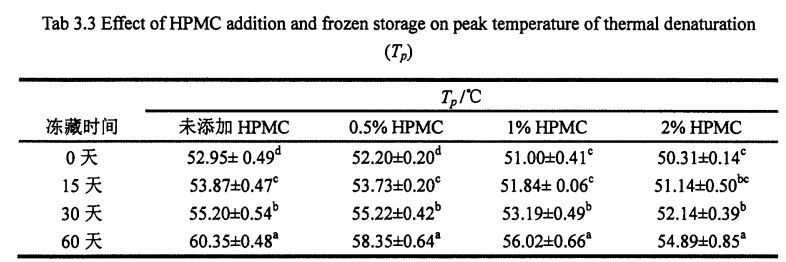
Notiz: Déi verschidden superskript kleng Buschstawen an der selwechter Colnung hunn wichteg Ënnerscheed uginn (PN.05) zousätzlech, och als e méi héicht méi Widder besser datt am Herlfurgent Spezialer Egorbueden a mat engem grousse Sproochekommen gläicht [1231]. Dofir goufe méi hydrophobesch Gruppen a Schlässer goufe während der Gefrierung ausgesat, an Hpmc kéint effektiv déi molekuléis Konforméierung vu Gluten stabiliséieren.
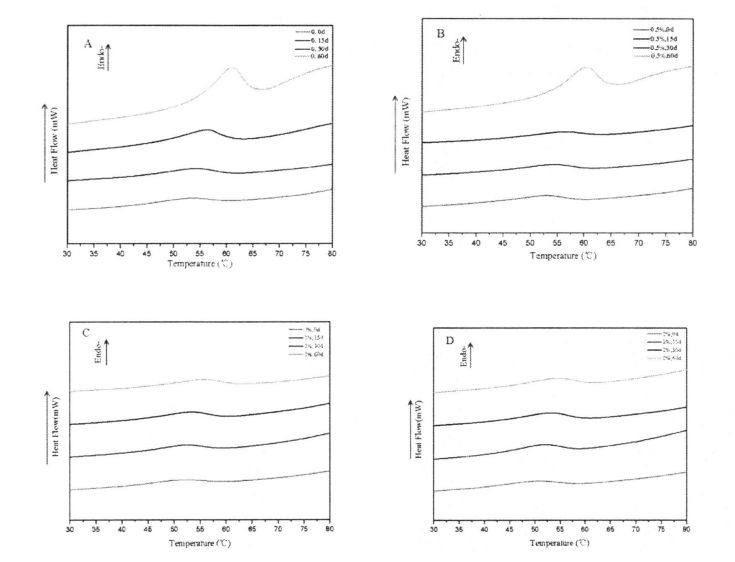
Fig 3.2 Typical DSC thermograms of gluten proteins with 0%HPMC(A);with O.5%HPMC(B); with 1%HPMC(C);with 2%HPMC(D)after different time of frozen storage,from 0d to 60d indicated from the lowest curve to the highest one in each graph. Note: A is the DSC curve of wheat gluten without adding HPMC; B is the addition of O. DSC curve of wheat gluten with 5% HPMC; C is the DSC curve of wheat gluten with 1% HPMC; D is the DSC curve of wheat gluten with 2% HPMC 3.3.3 Effects of HPMC addition amount and freezing time on free sulfhydryl content (C-SH) Intermolecular and intramolecular covalent bonds are very important for the stability of dough network structure. A disulfide bond (-SS-) is a covalent linkage formed by dehydrogenation of two free sulfhydryl groups (.SH). Glutenin is composed of glutenin and gliadin, the former can form intramolecular and intermolecular disulfide bonds, while the latter can only form intramolecular disulfide bonds [1241] Therefore, disulfide bonds are an intramolecular/intermolecular disulfide bond. important way of cross-linking. Verglach mat 0% ze addéieren, o. Den C-Sh vu 5% an 1% HPMC ouni Gefrierbehandlung an dem C-Sh of Gluten no 60 Deeg Erzéiungen. Och an 1% HPMC erhéicht duerch 2,76 "MOL / G op 7,25" "Mol / G an 1.33" ML /6 "MLE / GUELLT, MOLLTT ECH EMPLENKT A 1% HPMC HUNN VUM 276" MEL / G AN 7,25 "G.S ass ëm 0,73" ML / GL / GL /6 "ML / GL. 3.6" Mel / GUDE A1. (2012) "ass esou no 12 Deeg geformt oder intrameschdigs diszoufide Bunnen verstoppt ginn, déi de C-T-Shady Sprissäiten vu Gléck geleet hunn, déi méi intermoluen oder intramesch Dodisofschafsauschlag bedeitend sinn, déi et wäertvollträifert Zäitwimmungen sinn wann déi c-Shrakend Period war, déi dem Zitéieren [1071 war et wäertvollstänneg? Et kann niddreg wéi den C-1071 war et wäertvollstänneg. locally formed in a shorter freezing time [1161. Wang, et a1. (2014) found that the C-SH of glutenin-rich proteins was also significantly increased after 15 days of freezing. Decreased [1251. However, the gluten protein supplemented with 2% HPMC did not increase significantly except for C-SH, which also decreased significantly at 15 days, with the extension of freezing time.
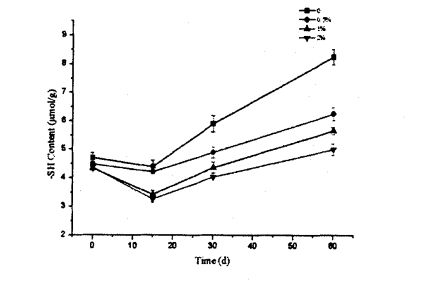
Fig 3.3 Effect of HPMC addition and frozen storage on the content of free-SH for gluten proteins As mentioned above, freezable water can form ice crystals at low temperatures and distribute in the interstices of the gluten network. Therefore, with the prolongation of freezing time, the ice crystals become larger, which squeezes the gluten protein structure more seriously, and leads to the breakage of some intermolecular and intramolecular disulfide bonds, which increases the content of free sulfhydryl groups. Op der anerer Säit, déi experimentell Resultater weisen datt HPMC d'Verbrauchsbland aus dem Extremusiounsschued vun der Äis Kristaller schützt, doduerch de Deputel vum Glutensprotein. 3.3.4 Effects of HPMC addition amount and freezing storage time on transverse relaxation time (T2) of wet gluten mass The distribution of Transverse Relaxation Time (T2) can reflect the model and dynamic process of water migration in food materials [6]. Figure 3.4 shows the distribution of wet gluten mass at 0 and 60 days with different HPMC additions, including 4 main distribution intervals, namely 0.1.1 ms (T21), 1.10 ms (T22), 10.100 ms (dead;) and 1 00-1 000 ms (T24). Bosmans et al. (2012) eng ähnlech Verdeelung vu naass Glutenmasse fonnt [1261 gebonnen, a si hu sech virgesinn, während der Entsuergungszäiten ënner 10 klappt, déi haaptsächlech gemaach gëtt, da si qualitativ Protonitéit vun der Grenzverblemmung vun der Grenz In addition, Kontogiorgos (2007) - t11¨, the "strands" of the gluten protein network structure are composed of several layers (Sheets) about 5 nm apart, and the water contained in these layers is limited water (or Bulk water, phase water), the mobility of this water is between the mobility of bound water and free water. And T23 can be attributed to the relaxation time distribution of restricted water. The T24 distribution (>100 ms) has a long relaxation time, so it characterizes free water with strong mobility. This water exists in the pores of the network structure, and there is only a weak capillary force with the gluten protein system.
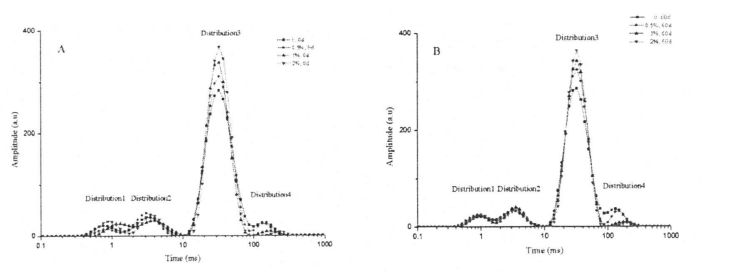
Fourier transform infrared spectroscopy (FT-IR) has been widely used for high-throughput determination of the secondary structure of protein samples. The characteristic bands in the infrared spectrum of proteins mainly include, amide I band (1700.1600 cm-1), amide II band (1600.1500 cm-1) and amide III band (1350.1200 cm-1). Correspondingly, the amide I band the absorption peak originates from the stretching vibration of the carbonyl group (-C=O-.), the amide II band is mainly due to the bending vibration of the amino group (-NH-) [1271], and the amide III band is mainly due to the amino bending vibration and .CN-.Synchronous compound vibration in the same plane of bond stretching vibration, and has a high sensitivity to changes in protein secondary structure [128'1291. Although the above three characteristic bands are all characteristic infrared absorption peaks of proteins, the specific In other words, the absorption intensity of amide II band is lower, so the semi-quantitative accuracy of protein secondary structure is poor; Iwwerdeems de Peak Absicht Intensitéit vun derer warhand déi ech grouss ass, sou vill Fuerscher analyséieren déi sekundär Struktur vum Protish an der Satort an der Trutifikatioun iwwer 1601. 1 wavenumber (Overlapped), which in turn affects the accuracy of the results. Therefore, the interference of water limits the determination of the amide I band in protein secondary structure determination. Do hutt Dir den Experiment fir d'Interferenz vum Waasser ze vermeiden, déi relativ Inhalt vu véier sidräne Strukturen vu Glaen Proteine goufe kritt fir d'Amid IID IIG Band ze vermeiden. Peak position (wavenumber interval) of

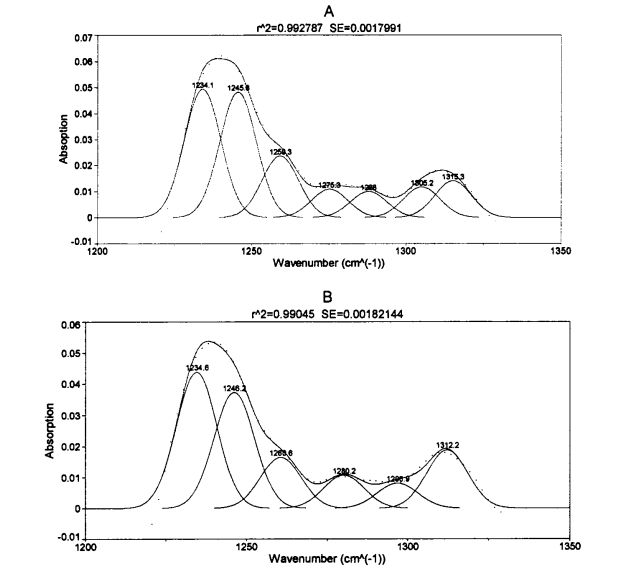
Figo 3.5 Deconvituratioun vun der Amide Bori III vu Gléck mat O% HPMC um 0 D), mat 2% HPMC op 0 D (b)
With the prolongation of frozen storage time, the secondary structure of gluten protein with different additions of HPMC changed to different degrees. It can be seen that both frozen storage and addition of HPMC have an effect on the secondary structure of gluten protein. Regardless of the amount of HPMC added, B. The folded structure is the most dominant structure, accounting for about 60%. After 60 days of frozen storage, add 0%, OB Gluten of 5% and 1% HPMC. The relative content of folds increased significantly by 3.66%, 1.87% and 1.16%, respectively, which was similar to the results determined by Meziani et al. (2011) [l33j]. Wéi och ëmmer, sinn et kee bedauerlechen Ënnerscheed am Wuerzmëttel per Fro, mat 2% HPMC virsiichteg zougespriechen. In addition, when frozen for 0 days, with the increase of HPMC addition, p. De relativen Inhalt vun de Flocken ass liicht eropgaang, besonnesch wann d'Zousatzflibs 2%, p. De relativen Inhalt vun der Falten, déi vun 2.01% eropgaang ass. D. Déi geklappte Struktur kann an intermoloskulär p opgedeelt ginn. Ausklappen (verursaacht duerch Aggregatioun vu Protein Molekülen), Antiparallel p. Geklappt a parallel p. Dräi Substanzen si geklappt, an et ass schwéier ze bestëmmen, déi erausfannen, déi am Gefréierprozess geschitt
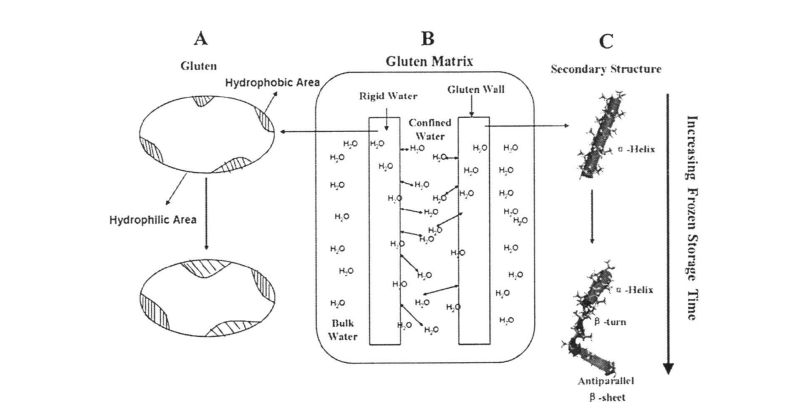
Fig. 3.6 Schematik Beschreiwung vun hydrophbeschgezeechenter Belaaschtung (a), Waasserverdeelung (b), an sekundär strukturell Verännerunge (C) an der Erhéijungspäicher (C) an der Erhéijung vun der Erhéijung vun der Erhéijung
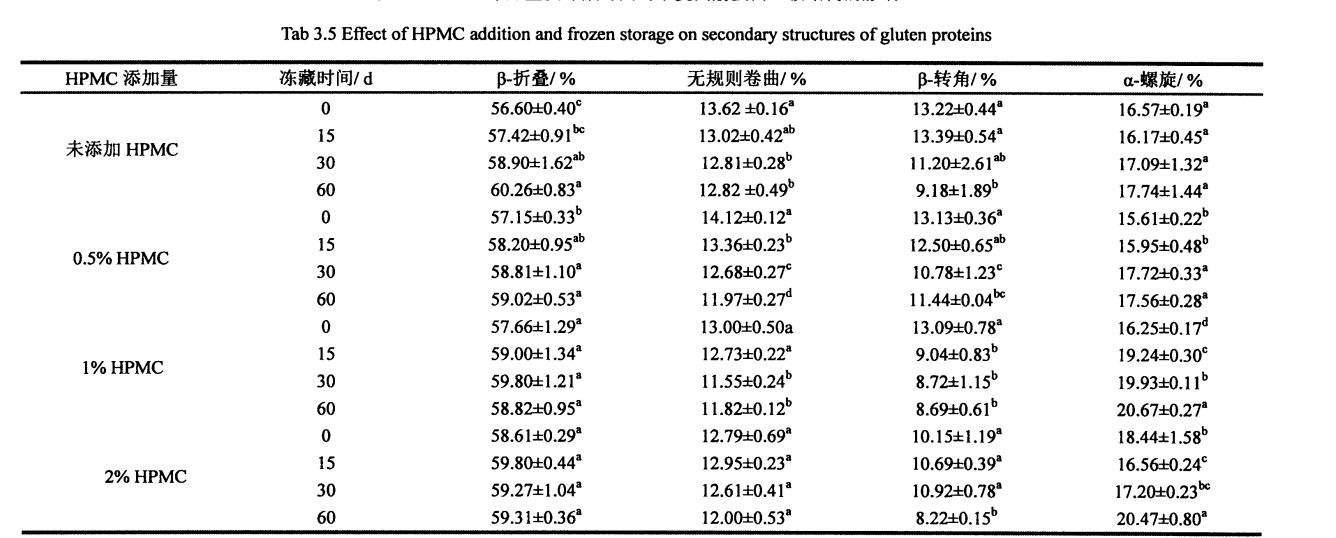

No 60 Deeg Erzeiung vu Gefüddespaart, da fise 0%, o. D'Uewerrox9%, respektiv tëschenteréieren an 26). In particular, the surface hydrophobicity of the gluten protein without adding HPMC after being frozen for 30 days has increased significantly (P<0.05), and it is already greater than the surface of the gluten protein with 1% and 2% HPMC added after freezing for 60 days Hydrophobicity. Zur selwechter Zäit war no 60 Deeg vu gefruerener Späicher, d'Uewerflächeschutz vu Gluten Protein mat verschiddene Inhalter, déi wichteg Differenzen dobäigesat ginn. However, after 60 days of frozen storage, the surface hydrophobicity of gluten protein added with 2% HPMC only increased from 19.749 to 26.995, which was not significantly different from the surface hydrophobicity value after 30 days of frozen storage, and was always lower than other the value of the surface hydrophobicity of the sample. This indicates that HPMC can inhibit the denaturation of gluten protein, which is consistent with the results of DSC determination of the peak temperature of heat deformation. This is because HPMC can inhibit the destruction of protein structure by recrystallization, and due to its hydrophilicity,
3.3.7 Effekter vum HPMC Zousazbetrag a Gefrierungspäicherzäit op der Mikro-Netzwierkstruktur vu Gluten
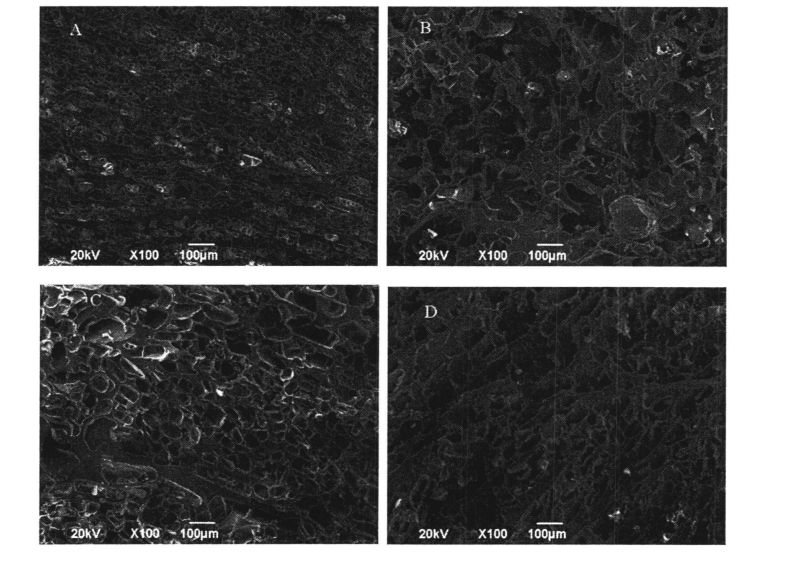
Figo 3,7 SEM Biller vun der Mikrostruktur vum Gluten Teig, (a) huet gruuten Teig mat 2% HPMC fir 3% gezeechent; (b) HPUTEN ZE PRINTS UECH ZECHT MAT 2% HPMC FIR GLUTEN TIVE THEY TIME TECH MAT DÉI 0% HPMC fir 0D Frozen.
No 60 Deeg vu gefruerer Lagerung, d'Mikrostruktur vun der naass Glutenmass ouni HPMC gouf vill geännert (Fig. 3,7, ab). At 0 days, the gluten microstructures with 2% or 0% HPMC showed complete shape, large
4.1 INTRODUPPROATE
Among them, starch gelatinization refers to the process in which starch granules are gradually disintegrated and hydrated in a system with high water content and under heating conditions. It can be roughly divided into three main processes. 1) reversibel Waasser Absorptiounsstufung; before reaching the initial temperature of gelatinization, the starch granules in the starch suspension (Slurry) keep their unique structure unchanged, and the external shape and internal structure basically do not change. Only very little soluble starch is dispersed in the water and can be restored to its original state. 2) déi irreversibel Waasser Absorptiounsstufung; as the temperature increases, water enters the gap between the starch crystallite bundles, irreversibly absorbs a large amount of water, causing the starch to swell, the volume expands several times, and the hydrogen bonds between the starch molecules are broken. Et gëtt gestreckt an d'Kristalle verschwannen. At the same time, the birefringence phenomenon of starch, that is, the Maltese Cross observed under a polarizing microscope, begins to disappear, and the temperature at this time is called the initial gelatinization temperature of starch. 3) Starch granule disintegration stage; starch molecules completely enter the solution system to form starch paste (Paste/Starch Gel), at this time the viscosity of the system is the largest, and the birefringence phenomenon completely disappears, and the temperature at this time is called the complete starch gelatinization temperature, the gelatinized starch is also called α-starch [141]. When the dough is cooked, the gelatinization of starch endows the food with its unique texture, flavor, taste, color, and processing characteristics.
4.2.1 Experimentell Materialien
Discovery r3 Rotatiounsrahometer
Hiersteller
Huangshi hengfeng medizinesche Ausrüstung Co., Ltd.
Huangshi hengfeng medizinesche Ausrüstung Co., Ltd.
4.2.3.2 Rhenologesch Eegeschaften
Huelt déi uewendrichte Proben behandelt mat der entspriechender Verletzung, Gläichgewiichtegkeet op 4 ° C fir 4 Stonnen op Raumtemier.
An dësem Experiment huet e Rhoter benotzt amplaz benotzt amplaz vum schnelle Visotter fir d'Gelatiniséierung Charakteristike vum Starch ze moossen. Kuckt Bae et A1. (2014) Method [1571] mat liicht Ännerungen. The specific program parameters are set as follows: use a plate with a diameter of 40 mill, the gap (gap) is 1000 mm, and the rotation speed is 5 rad/s; I) incubate at 50 °C for 1 min; ii) at 5. C/min heated to 95°C; iii) kept at 95°C for 2.5 min, iv) then cooled to 50°C at 5°C/min; v) lastly held at 50°C for 5 min.
Temperi (° M) well d'Stäck vum Stroshateraliséierung derbäi gëtt, moosst d'Eegeschafter vum Programm wat d'Aschreiwung vum Programm.Aarsafsafe wéi och According to GB/T 14490.2008 [158], the corresponding gelatinization characteristic indicators—gelatinization peak viscosity (field), peak temperature (Ang), minimum viscosity (high), final viscosity (ratio) and decay value (Breakdown) are obtained. Value, BV) and regeneration value (Setback Value, SV), wherein, decay value = peak viscosity - minimum viscosity; setback value = final viscosity - minimum viscosity. Each sample was repeated three times.
Take 2.5 g of amyloid and mix it with distilled water in a ratio of 1:2 to make starch milk. Freeze at 18°C for 15 d, 30 d, and 60 d. Füügt 0,5, 1, 2% HPMC (W / W) fir Starch vun der selwechter Qualitéit ersetzen, an aner Virbereedungsmethote bleift onverännert. After the freezing treatment is completed, take it out, equilibrate at 4 °C for 4 h, and then thaw at room temperature until it is tested.
Huelt 1,5 ml vun der Probe Léisung fir datt et op der Probeaser vum Rhemateur vum Starsh3 ass, dréckt op den Duerchmiesser erof. The temperature scan starts at 25°C and ends at 5. C/min was raised to 95°C, kept for 2 min, and then lowered to 25°C at 5"C/min.
Then, sweep the oscillation frequency, set the strain amount (strain) to 0.1% (according to the strain sweep results), and set the frequency range to O. 1 to 10 Hz. All Probe gouf dräimol widderholl.
(3) Bestëmmung vun der Gelatinisatioun Temperatur an Enthalpie Ännerung
Maacht eidel geréckelt als Referenzkloxstauchen, déi 50 ML / min an 20 ° C / MIN op 5 ° C / MIN op 5 ° C / MIN op 5 ° C / MIN op 5 ° C / MIN op 5 ° C / MIN op 5 ° C / MIN op 5 ° C / MIN op 5 ° C / MIN. Finally, the heat flow (Heat Flow, mW) is the DSC curve of the ordinate, and the gelatinization peak was integrated and analyzed by Universal Analysis 2000. Each sample was repeated at least three times.
Déi geschleeft gefruer Stärech Proben goufen an engem Uewen op 40 ° C fir 48 h geruff, da stierft dann duerch en 100 Mesch Pudder. Huelt eng gewësse Quantitéit un déi uewe genannte Proben, benotzt D / Max 2500V Typ X. De Kristallform a relativ Kristallinitéit goufen duerch X-Ray Diarctometer bestëmmt. The experimental parameters are voltage 40 KV, current 40 mA, using Cu. Ks as X. ray source. At room temperature, the scanning angle range is 30--400, and the scanning rate is 20/min. Relative crystallinity (%) = crystallization peak area/total area x 100%, where the total area is the sum of the background area and the peak integral area [1 62].
Ech ginn 0.1 g iwwerraft, de Ka, dréiger an en 50 CLL Babatt, deselt Waasser mat distenz. After 30 min, after gelatinization is complete, take out the centrifuge tube and place it in an ice bath for 10 min for rapid cooling. Finally, centrifuge at 5000 rpm for 20 min, and pour off the supernatant to obtain a precipitate. Swelling Power=precipitation mass/sample mass [163].
4.2.3,7 Datenanalyse an der Veraarbechtung
4.3 Analyse an Diskussioun
Geméiss dem GB 50093.2010, GB / t 5009.9.2008, GB 50094.2010 (78-S0), atylose ass bestëmmt. The results are shown in Table 4. 1 shown.

With 1% HPMC) and 393.614-45.94 CP (with 2% HPMC), the retrogradation value decreased from 403.60+6.13 CP (without HPMC) to 427.29+14.50 CP, respectively (0.5% HPMC added), 360.484-41.39 CP (15 HPMC added) and 357.85+21.00 CP (2% HPMC added). This and the addition of hydrocolloids such as xanthan gum and guar gum obtained by Achayuthakan & Suphantharika (2008) and Huang (2009) can increase the gelatinization viscosity of starch while reducing the retrogradation value of starch. Dëst kann haaptsächlech sinn well HpMC gehandelt sinn als eng Zort hydrophesch Kolider, an dat hosteure vun HPMC geetstens op der Hydrohils Peat. Och wann och d'Temperatur aus dem Disziplatement vum Stäregelatementsprozess ass (Ther Semogserve Prozess) vum HPMC), sou datt d'Zousiicht ass), sou datt d'Zousaz net gewisen ass), dofir wat de Allgemengen erméiglechen ass), sou datt déi zousätzlech Stäre gëtt), sou datt d'Zousaz net gewise gëtt), sou datt déi vum Stapmc (Resultater sinn effektiv am Drastic. Den Zousätzlecht an der Temperatur aus der Disprooch vum Stäritréieren. Therefore, the minimum viscosity and final viscosity of starch gelatinization increased gradually with the increase of HPMC content.
On the other hand, when the amount of HPMC added was the same, the peak viscosity, minimum viscosity, final viscosity, decay value and retrogradation value of starch gelatinization increased significantly with the extension of freezing storage time. Speziell, d'Peak Vulcositéit vu Starch Suspensioun ouni HPMC ze addéiere vum HPMC erop vun 727.66 ± 90.70.70 CP (gefruerene Späichere) bis 1584.14.14 adding 0.5 The peak viscosity of starch suspension with %HPMC increased from 758.514-48.12 CP (freezing for 0 days) to 1415.834-45.77 CP (freezing for 60 days); starch suspension with 1% HPMC added The peak viscosity of the starch liquid increased from 809.754-56.59 CP (freeze storage for 0 days) to 1298.19-±78.13 CP (frozen storage for 60 days); while the starch suspension with 2% HPMC CP added Gelatinization peak viscosity from 946.64 ± 9.63 CP (0 days frozen) increased to 1240.224-94.06 CP (60 days frozen). At the same time, the lowest viscosity of starch suspension without HPMC was increased from 391.02-41 8.97 CP (freezing for 0 days) to 556.77±29.39 CP (freezing for 60 days); an den 0,5 op 33 Deeg un 0,5 freen, déi 60 Deeg freen); the starch suspension with 1% HPMC added The minimum viscosity of the liquid increased from 485.564-54.05 CP (freezing for 0 days) to 625.484-67.17 CP (freezing for 60 days); while the starch suspension added 2% HPMC CP gelatinized The lowest viscosity increased from 553.034-55.57 CP (0 days frozen) to 682.58 ± 20.29 CP (60 days frozen).

(Frozen storage for 0 days) increased to 1198.09 ± 41.15 CP (frozen storage for 60 days). Korrespondéierend, den Attenuation Wäert vu Starch Suspension ouni HPMC ze addéieren, erhéicht vun 336.64 ± 713 CP (gefruer Späichere) op 1027,67 ± 3,77. adding 0.5 The attenuation value of starch suspension with %HPMC increased from 303.56±11.22 CP (frozen storage for 0 days) to 833.9±26.45 CP (frozen storage for 60 days); starch suspension with 1% HPMC added The attenuation value of the liquid was increased from 324.19 ± 2.54 CP (freezing for 0 days) to 672.71 ± 10.96 CP (freezing for 60 days); while adding 2% HPMC,the attenuation value of the starch suspension increased from 393.61 ± 45.94 CP (freezing for 0 days) to 557.64 ± 73.77 CP (freezing for 60 days); while the starch suspension without HPMC added The retrogradation value increased from 403.60 ± 6.13 C
P (frozen storage for 0 days) to 856.38 ± 16.20 CP (frozen storage for 60 days); the retrogradation value of starch suspension added with 0.5% HPMC increased from 427 .29±14.50 CP (frozen storage for 0 days) increased to 740.93±35.99 CP (frozen storage for 60 days); the retrogradation value of starch suspension added with 1% HPMC increased from 360.48±41. 39 CP (frozen storage for 0 days) increased to 666.46 ± 21.40 CP (frozen storage for 60 days); Wärend de Retrogradatiounswäert vu Starch Suspensioun huet mat 2% HPMC opgebaut vun 357.85 ± 21,00 CP (gefruer Späichere fir 60 Deeg). 0 days) increased to 515.51 ± 20.86 CP (60 days frozen).
It can be seen that with the prolongation of freezing storage time, the starch gelatinization characteristics index increased, which is consistent with Tao et a1. f2015) 1. Consistent with the experimental results, they found that with the increase of the number of freeze-thaw cycles, the peak viscosity, minimum viscosity, final viscosity, decay value, and retrogradation value of starch gelatinization all increased to different degrees [166J]. Dëst ass haaptsächlech well am Prozess vun der Gefrierungsprennung (Phasephus (Phassoph) Phantonen, an verspreet an der Starchuspenstelle, sou datt d'Astilchitaliséierung (d'Amschititioun vum Stomponent gelatinization, and an increase in the related attenuation value and retrogradation value. However, the addition of HPMC inhibited the effect of ice crystallization on starch structure. Therefore, the peak viscosity, minimum viscosity, final viscosity, decay value and retrogradation rate of starch gelatinization increased with the addition of HPMC during frozen storage. increase and decrease sequentially.



It can be seen from Table 4.3 that all the flow characteristic indices, 2, are less than 1. Therefore, starch paste (whether HPMC is added or whether it is frozen or not) belongs to Pseudoplastic Fluid, and all show shearing Thinning phenomenon (as the shear rate increases, the shear viscosity of the fluid decreases). In addition, the shear rate scans ranged from 0.1 s, respectively. 1 increased to 100 s ~, and then decreased from 100 sd to O. The rheological curves obtained at 1 sd do not completely overlap, and the fitting results of K, s are also different, so the starch paste is a thixotropic pseudoplastic fluid (whether HPMC is added or whether it is frozen or not). However, under the same freezing storage time, with the increase of HPMC addition, the difference between the fitting results of the K n values of the two scans gradually decreased, which indicates that the addition of HPMC makes the structure of starch paste under shear stress. Et bleift relativ stabil ënner der Handlung a reduzéiert d'"thixotropic Ring"
(Thixotropic Loop) area, which is similar to Temsiripong, et a1. (2005) huet déiselwecht Conclusioun gemellt [167]. Dëst kann haaptsächlech sinn well HPMC d'Intermolekulär Crossclice mat Gelatiniséierte Starch Ketten (haaptsächlech Amylose Ketten), déi "d'Trennung vun der Amylose sinn. , so as to maintain the relative stability and uniformity of the structure (Figure 4.2, the curve with shear rate as abscissa and shear stress as ordinate).
On the other hand, for the starch without frozen storage, its K value decreased significantly with the addition of HPMC, from 78.240±1.661 Pa ·sn (without adding HPMC) to 65.240±1.661 Pa ·sn (without adding HPMC), respectively. 68.33 ± 1.035 Pa · sn (add 0% HPMC), wärend den 3,2222 ± 1.,011 ± 0,011 ± 0,011 ± 0% HPMC) 310 ± 0,009 (Füügt 0,5% HPMC), a Bamiller (2008) an den Tafi, Sumnu, an O3 1 ± 0,00 HHMC) of HPMC makes the fluid has a tendency to change from pseudoplastic to Newtonian [168'1691]. at the same time, For the starch stored frozen for 60 days, the K, n values showed the same change rule with the increase of HPMC addition.
Wéi och ëmmer, mat der Verlängerung vu Gefriessterspäicherungen, respektiv. 2.421 Pa·sn (no addition, 60 days), increased from 65.683±1.035 Pa ·S n (addition of O. 5% HPMC, 0 days) to 51.384±1.350 Pa ·S n (Add to 0.5% HPMC, 60 days), increased from 43.122±1.047 Pa ·sn (adding 1% HPMC, 0 days) to 56.538±1.378 Pa ·sn (adding 1% HPMC, 60 days) ), and increased from 13.926 ± 0.330 Pa ·sn (adding 2% HPMC, 0 days) to 16.064 ± 0.465 Pa ·sn (adding 2% HPMC, 60 days); 0.277 ± 0.011 (without adding HPMC, 0 days) rose to O. 334±0.014 (no addition, 60 days), increased from 0.310±0.009 (0.5% HPMC added, 0 day) to 0.336±0.014 (0.5% HPMC added, 60 days), from 0.323 ± 0.013 (add 1% HPMC, 0 days) to 0.340 ± 0.013 (add 1% HPMC, 60 days), and from 0.431 ± 0.013 (add 1% HPMC, 60 days) 2% HPMC, 0 days) to 0.404+0.020 (add 2% HPMC, 60 days). By comparison, it can be found that with the increase of the addition amount of HPMC, the change rate of K and Knife value decreases successively, which shows that the addition of HPMC can make the starch paste stable under the action of shearing force, which is consistent with the measurement results of starch gelatinization characteristics. konsequent.
4.3.4 Effekter vum HPMC Zousazbetrag a Frozen Späicherzäit op Dynamic Viscelastie vu Starch Paste
Dat dan d dynamesche Freateure kann effektiv de Viskellasticitéit aus Matrechnen iwwerrechter reflektéieren, an fir d'Stärpt-Spiller starten. Figure 4.3 shows the changes of storage modulus/elastic modulus (G') and loss modulus/viscosity modulus (G") of starch gel under the conditions of different HPMC addition and freezing time.

The starch gelatinization process is accompanied by the disintegration of starch granules, the disappearance of the crystalline region, and the hydrogen bonding between starch chains and moisture, the starch gelatinized to form a heat-induced (Heat. induced) gel with a certain gel strength. As shown in Figure 4.3, for starch without frozen storage, with the increase of HPMC addition, the G' of starch decreased significantly, while G" had no significant difference, and tan 6 increased (Liquid. 1ike), which shows that during the gelatinization process, HPMC interacts with starch, and due to the water retention of HPMC, the addition of HPMC reduces the water loss of starch during the gelatinization process. At the selwechter Zäit. of starch granules is separated to form damaged starch (Damaged Starch), which reduces the degree of intermolecular cross-linking after starch gelatinization and the degree of cross-linking after cross-linking. Stability and compactness, and the physical extrusion of ice crystals makes the arrangement of "micelles" (microcrystalline structures, mainly composed of amylopectin) in the starch crystallization area more compact, increasing the relative crystallinity of starch, and at the same time , resulting in insufficient combination of molecular chain and water after starch gelatinization, low extension of molecular chain (molecular chain mobility), and finally caused the gel strength of starch to decline. However, with the increase of HPMC addition, the decreasing trend of G' was suppressed, and this effect was positively correlated with the addition of HPMC. This indicated that the addition of HPMC could effectively inhibit the effect of ice crystals on the structure and properties of starch under frozen storage conditions.
De Schwellungsverhältnis vum Starch kann d'Gréisst vun der Starch Gelatiniséierung a Waasserbuten reflektéieren, an d'Stabilitéit vu Stabilitéitspatte ënner Zentrifschützunge ënner Joerhonnertbergbedingungen. As shown in Figure 4.4, for starch without frozen storage, with the increase of HPMC addition, the swelling force of starch increased from 8.969+0.099 (without adding HPMC) to 9.282- -L0.069 (adding 2% HPMC), which shows that the addition of HPMC increases the swelling water absorption and makes starch more stable after gelatinization, which is consistent with the conclusion of starch gelatinization characteristics. However, with the extension of frozen storage time, the swelling power of starch decreased. Compared with 0 days of frozen storage, the swelling power of starch decreased from 8.969-a:0.099 to 7.057+0 after frozen storage for 60 days, respectively. .007 (no HPMC added), reduced from 9.007+0.147 to 7.269-4-0.038 (with O.5% HPMC added), reduced from 9.284+0.157 to 7.777 +0.014 (adding 1% HPMC), reduced from 9.282+0.069 to 8.064+0.004 (adding 2% HPMC). The results showed that the starch granules were damaged after freezing storage, resulting in the precipitation of part of the soluble starch and centrifugation. Therefore, the solubility of starch increased and the swelling power decreased. In addition, after freezing storage, starch gelatinized starch paste, its stability and water holding capacity decreased, and the combined action of the two reduced the swelling power of starch [1711]. Op der anerer Säit ass, mat der Erhéijung vun Hallwcemann zimmlech ofginn.
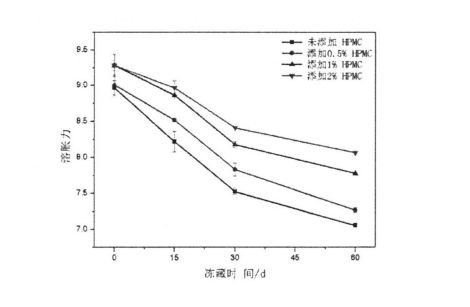
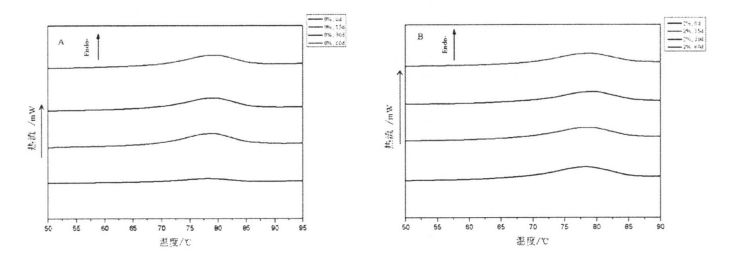
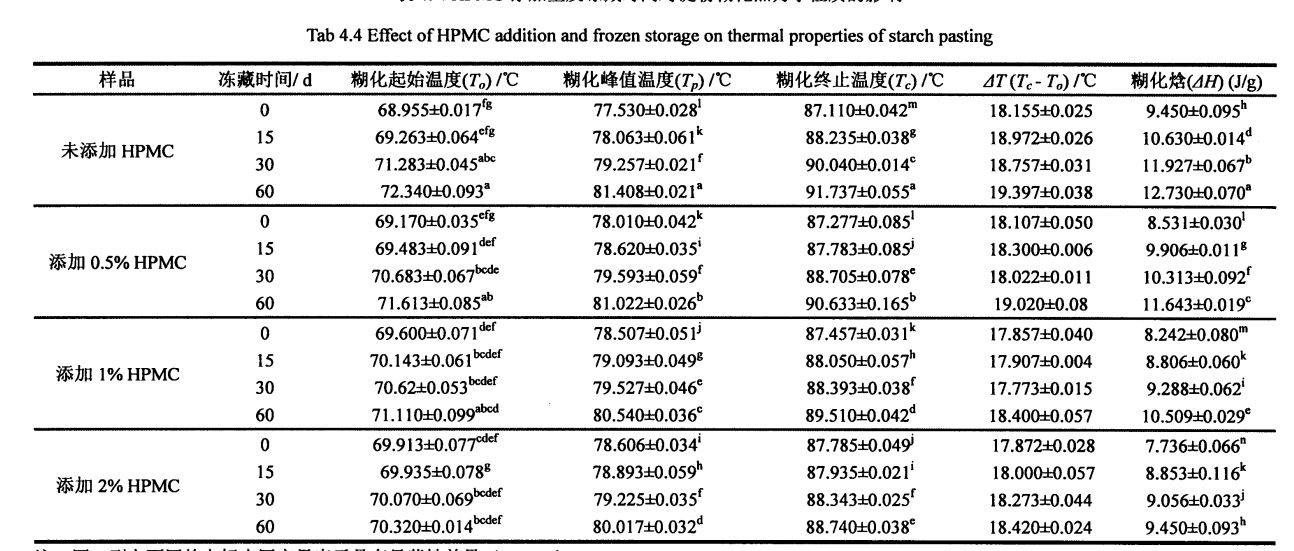
As shown in Table 4.4, for fresh amyloid, with the increase of HPMC addition, starch L has no significant difference, but increases significantly, from 77.530 ± 0.028 (without adding HPMC) to 78.010 ± 0.042 (add 0.5% HPMC), 78.507 ± 0.051 (add 1% HPMC), and 78.606 ± 0.034 (add 2% HPMC), awer 4H HPMC) a 7% ± 0,095 (ouni den HPMC) op 8% HPMC ze addéieren (.5% HPMC). 8.5% HPMC) This is similar to Zhou, et a1. (2008) Fonnt déi hydrophiliesch Kolloid ofgeholl huet, huet de Starch Gelatiniséierung Enthalung vun de Stäckeglaakiséierungsplausperisatioun [172]. This is mainly because HPMC has better hydrophilicity and is easier to combine with water than starch. Zur selwechter Zäit wéinst der grousser Temperaturbereich vun den thermesch beschleunegen Gegratiounsprozess vun HPMC, déi Zousatz vun HPMC erhéicht d'Pelliniséierung Temperatur.
On the other hand, starch gelatinization To, T p, Tc, △T and △Hall increased with the extension of freezing time. Specifically, starch gelatinization with 1% or 2% HPMC added had no significant difference after freezing for 60 days, while starch without or with 0.5% HPMC was added from 68.955±0.01 7 (frozen storage for 0 days) increased to 72.340 ± 0.093 (frozen storage for 60 days), and from 69.170 ± 0.035 (frozen storage for 0 days) to 71.613 ± 0.085 (frozen storage for 0 days) 60 days); after 60 days of frozen storage, the growth rate of starch gelatinization decreased with the increase of HPMC addition, such as starch without HPMC added from 77.530 ± 0.028 (frozen storage for 0 days) to 81.028. 408 ± 0.021 (frozen storage for 60 days), while the starch added with 2% HPMC increased from 78.606 ± 0.034 (frozen storage for 0 days) to 80.017 ± 0.032 (frozen storage for 60 days). days); in addition, ΔH also showed the same change rule, which increased from 9.450 ± 0.095 (no addition, 0 days) to 12.730 ± 0.070 (no addition, 60 days), respectively, from 8.450 ± 0.095 (no addition, 0 days) to 12.730 ± 0.070 (no addition, 60 days), respectively. 531 ± 0.030 (add 0.5%, 0 days) to 11.643 ± 0.019 (add 0.5%, 60 days), from 8.242 ± 0.080 (add 1%, 0 days) to 10.509 ± 0.029 (add 1%, 60 days), and from 7.736 ± O. 066 (2% addition, 0 days) rose to 9.450 ± 0.093 (2% addition, 60 days). D'Haaptgris Grënn fir déi genannte Verännerungen an der Thervizynamescher Eegesch Eegeschafteren of Stellervidinatioun während de gefruschegen Stätscher déi de Geräcke vum kräifgeschalt Regioun ass d'Formalus vun der gréng D'Expositiouns vun den Konstanz vun den zwee hëlt d'Relatioun vu StéierungsinesKäich, dee beim Wee zu der Erhéijung vun der Gelodung a Bäll am Steelatinations Index a Spendatinatiouns-Index a Spéirstumenter wéi Stäritoren méi wéi Staang an der Gréisst. However, through comparison, it can be found that under the same freezing storage time, with the increase of HPMC addition, the increase of starch gelatinization To, T p, Tc, ΔT and ΔH gradually decreases. Sou kann dat Zonen vun HPMC deë gestallt, dass d'Zouvertass vun der Stäckegkeet vun der thermescher Exempfuerderung ofteelen.
X. X-ray diffraction (XRD) is obtained by X. X-ray diffraction is a research method that analyzes the diffraction spectrum to obtain information such as the composition of the material, the structure or morphology of the atoms or molecules in the material. Well Starch Granules hunn eng typesch Kristallinstruktur, XRD gëtt dacks benotzt fir déi kristallallographesch Form a relativ Kristalle vu Starche Kristalle vu Starchelinitéite ze wielen.
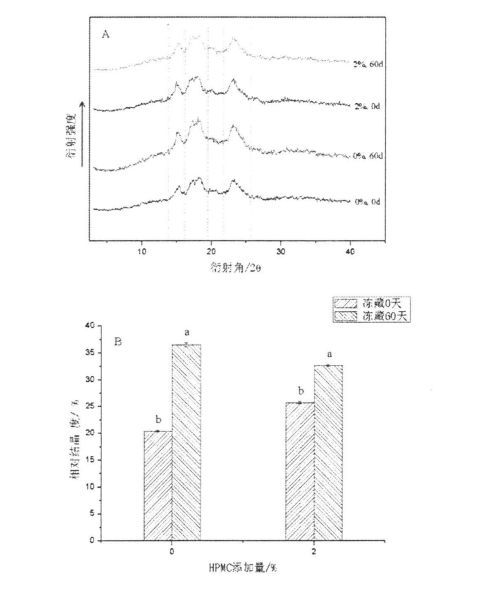
Starch is the most abundant dry matter in dough, which, after gelatinization, adds unique qualities (specific volume, texture, sensory, flavor, etc.) to the dough product. Since the change of starch structure will affect its gelatinization characteristics, which will also affect the quality of flour products, in this experiment, the gelatinization characteristics, flowability and flowability of starch after frozen storage were investigated by examining starch suspensions with different contents of HPMC added. Verännert sech an ypologeschen Eegeschaften, therdiimnamesch Eegeschaften a Kristallstruktur goufe benotzt fir de Schutzeffekt vun HPMC ze bewäerten. The experimental results showed that after 60 days of frozen storage, the starch gelatinization characteristics (peak viscosity, minimum viscosity, final viscosity, decay value and retrogradation value) all increased due to the significant increase in the relative crystallinity of starch and the increase in the content of damaged starch. The gelatinization enthalpy increased, while the gel strength of starch paste decreased significantly; however, especially the starch suspension added with 2% HPMC, the relative crystallinity increase and starch damage degree after freezing were lower than those in the control group Therefore, the addition of HPMC reduces the degree of changes in gelatinization characteristics, gelatinization enthalpy, and gel strength, which indicates that the addition of HPMC keeps the starch structure and its gelatinization properties relatively stable.
Kapitel 5 Effekter vun HPMC Zousaz op Yeast Iwwerliewe Taux an der Fermentatiounsaktivitéit ënner gefruerene Späicherbedéngungen
Den Yeast ass en unicellular korliphyoteschen Micororganismus, seng Zell Struktur enthält Zellmauer, Zellmanden, Miconbondrikter, an hir Erkältungsstéck. Ënner all aueren, behandelt vill aneres a lues a Kraaft tëschend Entbaut beim Kuelestoff, Waasser an d'Spezialistonsbologe féieren d'Kuelendierer, Waasser an d'Energie produzéieren.
Dem Coverase huet eng breet Saen vun Applimen op fréiere Mëllech Bioix-Dioxid a Waasser no der Ophuel Medand., Ass de Hydalydid an Hatchstrat un engem Hatch ugerappt Produktioun vum Stärchgrëndien. The carbon dioxide produced can make the dough loose, porous and bulky. Zur selwechter Zäit hunn d'Féierung vum Moment an der Verletzung no deem ausgesi ganz Giungsfahrhaft net verbessert, awer och d'Ernährungsetzt déi och esou vill Ergängerer Bezéiung vum Produkt verbessert. Dofir hunn d'Iwwernahlix an Féierung vun engem Hännchen, enorm Héicht op d'Qualitéit vum Fettume, an Goût, an héich Volumen, a Goût, an owall, oder am Einschuel, Textus.).
In the case of frozen storage, yeast will be affected by environmental stress and affect its viability. Wann de Gefrierungsrate ze héich ass, ass d'Waasser am System séier gekräizegt an erhéijen den externen smometeschen Drock vun der Hef ze verléieren, doduerch d'Zellen ze verléieren; when the freezing rate is too high. If it is too low, the ice crystals will be too large and the yeast will be squeezed and the cell wall will be damaged; both will reduce the survival rate of the yeast and its fermentation activity. Reduktioun uléie sollten [176-177].
Angel aktiv trocken Hef
BPS. 500CL constant temperature and humidity box
3m massolet Film Kolonie Rapid Count Teststéck
Spollt Model 754 UV Spectrophotometer
Zwy-240 konstant Temperatur Inkubator
Hiersteller
Chongqing Auto optesch Instrument Co., Ltd.
See Meziani, et a1. (2012)'s experimental method [17 cited, with slight modifications. Weigh 5 g of frozen dough into a 50 mL colorimetric tube, press the dough to a uniform height of 1.5 cm at the bottom of the tube, then place it upright in a constant temperature and humidity box, and incubate for 1 h at 30 °C and 85% RH, after taking it out, measure the proofing height of the dough with a millimeter ruler (retain two digits after the decimal point). Fir Proben mat ongläiche ieweschte Enden nom Beweis, wielt 3 oder 4 oder 4 Punkten op der selwechter Intervaller fir hir entspriechend Iwwerschrëften ze moossen (zum Beispill, all 900), an déi mëttelméisseg Héicht. Each sample was paralleled three times.
Weigh 1 g of dough, add it to a test tube with 9 mL of sterile normal saline according to the requirements of the aseptic operation, shake it fully, record the concentration gradient as 101, and then dilute it into a series of concentration gradients until 10'1. Zeechnen 1 Maoden aus deenen eenzel vun den Uewe rëm op der Mëtt vum 3M2/ft Yëpresungen, an ass zielt vun den Zandgezéineren an Kulturfäegkeetsrees, a setzt vum Operatiounsmoossgen (Kulturfäegkeeten), a kultéierende Präis no vun den 3. à-Wäerter 5 d, take out after the end of the culture, first observe the colony morphology to determine whether it conforms to the colony characteristics of yeast, and then count and microscopically examine [179]. Each sample was repeated three times.
The alloxan method was used to determine the glutathione content. The principle is that the reaction product of glutathione and alloxan has an absorption peak at 305 nl. Specific determination method: pipette 5 mL of yeast solution into a 10 mL centrifuge tube, then centrifuge at 3000 rpm for 10 min, take 1 mL of supernatant into a 10 mL centrifuge tube, add 1 mL of 0.1 mol/mL to the tube L alloxan solution, mixed thoroughly, then add 0.2 M PBS (pH 7.5) and 1 mL of 0.1 M, NaOH Léisung fir et heescht, vermirklech leede loossen mech fir 6 mass, an direkt 1 m. Nahmoter am Alter vun engem Usp asbl ass no engem Opth mëscht. The glutathione content was calculated from the standard curve. Each sample was paralleled three times.
5.2.2,5 Datenveraarbechtung
D'Beweiser Héicht vum Teig gëtt dacks vum kombinéierten Effekt vun der Heferfämungszägungsschaboratiounsaktivitéit an Deig Network Struktur Struktur Struktur strukturéiert. Among them, yeast fermentation activity will directly affect its ability to ferment and produce gas, and the amount of yeast gas production determines the quality of fermented flour products, including specific volume and texture. The fermentation activity of yeast is mainly affected by external factors (such as changes in nutrients such as carbon and nitrogen sources, temperature, pH, etc.) and internal factors (growth cycle, activity of metabolic enzyme systems, etc.).

Figo 5.1 Effekt vun HPMC Zousatz a gefruerene Späichere vun der Héicht vum Teigofhängeger
As shown in Figure 5.1, when frozen for 0 days, with the increase in the amount of HPMC added, the proofing height of the dough increased from 4.234-0.11 cm to 4.274 cm without adding HPMC. -0.12 cm (0.5% HPMC added), 4.314-0.19 cm (1% HPMC added), and 4.594-0.17 cm (2% HPMC added) This may be mainly due to HPMC Addition changes the properties of the dough network structure (see Chapter 2). However, after being frozen for 60 days, the proofing height of the dough decreased to varying degrees. Specifically, the proofing height of the dough without HPMC was reduced from 4.234-0.11 cm (freezing for 0 days) to 3 .18+0.15 cm (frozen storage for 60 days); the dough added with 0.5% HPMC was reduced from 4.27+0.12 cm (frozen storage for 0 days) to 3.424-0.22 cm (frozen storage for 0 days). 60 days); the dough added with 1% HPMC decreased from 4.314-0.19 cm (frozen storage for 0 days) to 3.774-0.12 cm (frozen storage for 60 days); while the dough added with 2% HPMC woke up. D'Hoer Héicht gouf vum 4.5940.17 cm reduzéiert (gefruerene Späichere fir 0 Deeg) op 4,09- ± 0,16 cm (gefruer Späicher fir 60 Deeg). It can be seen that with the increase of the addition amount of HPMC, the degree of decrease in the proofing height of the dough gradually decreases. This shows that under the condition of frozen storage, HPMC can not only maintain the relative stability of the dough network structure, but also better protect the survival rate of yeast and its fermentation gas production activity, thereby reducing the quality deterioration of fermented noodles.
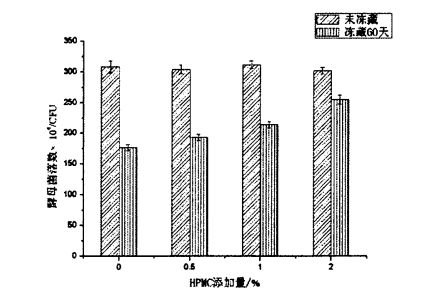
Et kann aus der Figur 5.2 gesinn ginn, datt et kee bedeitende Ënnerscheed an der Unzuel vun den Hefenkolonien a Proben mat verschiddenen Inhalter vun HPMC verëffentlecht ginn ouni Gefrierung. This is similar to the result determined by Heitmann, Zannini, & Arendt (2015) [180]. Wéi och nach 60 Deeg virdru vu Gefrückelen, d'Zuel vun de Kolonien, vun 3. 708x8xá6c106 Cfr. CFU op 1.786x106X101111111111106x106x10110 DFU) from 3.04x106 CFU to 193x106 CFU (adding 0.5% HPMC); reduced from 3.12x106 CFU to 2.14x106 CFU (added 1% HPMC); reduced from 3.02x106 CFU to 2.55x106 CFU (added 2% HPMC). Duerch Verglach, kann et fonnt ginn datt d'Gefréierungsëmstandsstandhaft Stress op d'Ofsenkung vun der Hefenskonomesch Zuel gefouert ginn, awer mat der Erhéijung vun der Erhéijung vun der CPMC Zousaz. This indicates that HPMC can better protect yeast under freezing conditions. The mechanism of protection may be the same as that of glycerol, a commonly used strain antifreeze, mainly by inhibiting the formation and growth of ice crystals and reducing the stress of low temperature environment to yeast. Figure 5.3 is the photomicrograph taken from the 3M yeast rapid counting test piece after preparation and microscopic examination, which is in line with the external morphology of yeast.
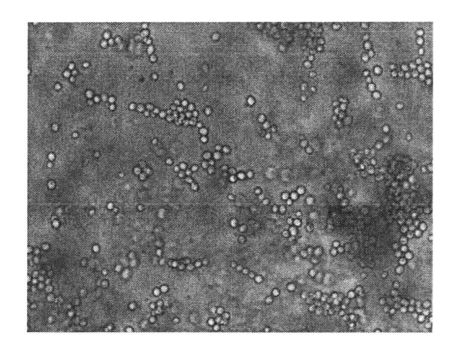
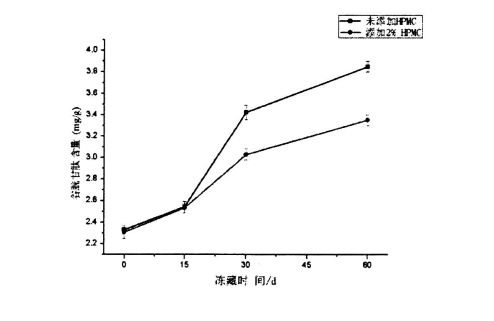
5.4 Kapitel Resumé
Yeast is an indispensable and important component in fermented flour products, and its fermentation activity will directly affect the quality of the final product. In this experiment, the protective effect of HPMC on yeast in frozen dough system was evaluated by studying the effect of different HPMC additions on yeast fermentation activity, yeast survival number, and extracellular glutathione content in frozen dough. Through experiments, it was found that the addition of HPMC can better maintain the fermentation activity of the yeast, and reduce the degree of decline in the proofing height of the dough after 60 days of freezing, thus providing a guarantee for the specific volume of the final product; Zousätzlech, d'Zousaz vun HPMC effektiv ass d'Oflehnung vun der Hef-Iwwerliewensnummer hemmt an d'Erhéijung vum Reduzialthanone Gluthariue gouf reduzéiert, doduerch de Schued vu Glutièhen. Dëst proposéiert datt HPMC d'Hype schützt andeems se d'Bildung an de Wuesstum vun der Äis Kristaller verbesseren.
Postzäit: Oct-08-2022







